

Sector zeroes in on growing role of data

TECHNOLOGY
won’t change the fundamentals of farming but it will remove some of its more onerous roles, says a tech leader.
AgriTech NZ chief executive Brendan O’Connell said farming in 20 to 30 years will still be underpinned by animal husbandry skills, but tools such as Halter and automated milking will remove some of the time-demanding, monotonous roles.
DairyNZ estimates farmers spend about five hours a week on compliance.
Hayley Morris, Fonterra’s business transformation digital lead, said the co-operative is on track to reduce by half the 1 million hours its suppliers and shareholders spend inputting data each year.
To date she estimates changes to its on-farm audits and annual farm diary records have saved them 507,000 hours, and Fonterra aims to hit its target within a year.
O’Connell imagines farmers in the future will have constant access to a digital assistant that, together with artificial intelligence (AI), will provide pertinent, up-todate information and data.
“It will be like a digital farmhand.”
O’Connell said a recent AI trial successfully scoured Pāmu’s farm
records to collate a report on greenhouse gas emissions without requiring any new information.
He likens the current state of technology to the human equivalent of teenage years, but believes we are entering a new stage of maturity as it becomes less clunky and awkward to use and developers start enabling it to interact with other programmes.
Farming leaders say technology must be appropriate to the task it seeks to address and provide information that is relevant to the person using it.
A 2022 report commissioned by AgriTech NZ into digital adoption in the primary industries found 59% of those surveyed were leaning towards adopting digital technology – but 41% saw little value for their business.
While there were trailblazers, it found farmers were generally less inclined to be early adopters than other sectors.
“Proudly traditionalist farmers and growers are reluctant to change what has worked for their land for many years,” the report said.
Most were happy to share data but many believed it had little value to someone else.
Managing business accounts, payroll and health and safety were areas with the biggest technology uptake, with lower adoption for management of water, irrigation, plant, crop and effluent.
Continued page 3


Cause and effect at MataRata Downs
Whether it is growing pasture, pine trees, native plantings or poplars, every inch of Jarred and Sarah Coogan’s 470ha Taranaki farm is effective. Photo: Bryan Gibson ON FARM 14-15 Big ideas come from

Freshwater farm plan changes could face first test in Canterbury. NEWS 3

Little Farms
A city girl and now an organic grower, Alex Morrissey began Little Farms from a desire to create a more sustainable food system.
HORTICULTURE 18-19
Community backlash prompts police to delay restructure decision. NEWS 4
Persuading shareholders to sell Alliance not easy, says Allan Barber.
OPINION 17

Neal Wallace TECHNOLOGY On farm
EDITORIAL
Bryan Gibson | 06 323 1519
Managing Editor bryan.gibson@agrihq.co.nz
Craig Page | 03 470 2469 Deputy Editor craig.page@agrihq.co.nz
Claire Robertson
Sub-Editor claire.robertson@agrihq.co.nz
Neal Wallace | 03 474 9240
Journalist neal.wallace@agrihq.co.nz
Gerald Piddock | 027 486 8346
Journalist gerald.piddock@agrihq.co.nz
Annette Scott | 021 908 400
Journalist annette.scott@agrihq.co.nz
Hugh Stringleman | 027 474 4003
Journalist hugh.stringleman@agrihq.co.nz
Richard Rennie | 027 475 4256
Journalist richard.rennie@agrihq.co.nz
Nigel Stirling | 021 136 5570
Journalist nigel.g.stirling@gmail.com
PRODUCTION
Lana Kieselbach | 027 739 4295 production@agrihq.co.nz
ADVERTISING MATERIAL
Supply to: adcopy@agrihq.co.nz
SUBSCRIPTIONS & DELIVERY 0800 85 25 80 subs@agrihq.co.nz
PRINTER
Printed by NZME Delivered by Reach Media Ltd
SALES CONTACTS
Andy Whitson | 027 626 2269
Sales & Marketing Manager andy.whitson@agrihq.co.nz
Janine Aish | 027 300 5990
Auckland/Northland Partnership Manager janine.aish@agrihq.co.nz
Jody Anderson | 027 474 6094
Waikato/Bay of Plenty Partnership Manager jody.anderson@agrihq.co.nz
Palak Arora | 027 474 6095
Lower North Island Partnership Manager palak.arora@agrihq.co.nz
Andy Whitson | 027 626 2269 South Island Partnership Manager andy.whitson@agrihq.co.nz
Julie Hill | 027 705 7181
Marketplace Partnership Manager classifieds@agrihq.co.nz
Andrea Mansfield | 027 602 4925 National Livestock Manager livestock@agrihq.co.nz
Real Estate | 0800 85 25 80 realestate@agrihq.co.nz
Word Only Advertising | 0800 85 25 80 Marketplace wordads@agrihq.co.nz
PUBLISHERS
Dean and Cushla Williamson Phone: 027 323 9407 dean.williamson@agrihq.co.nz cushla.williamson@agrihq.co.nz
Farmers Weekly is Published by AgriHQ PO Box 529, Feilding 4740, New Zealand Phone: 0800 85 25 80 Website: www.farmersweekly.co.nz
ISSN 2463-6002 (Print) ISSN 2463-6010 (Online)
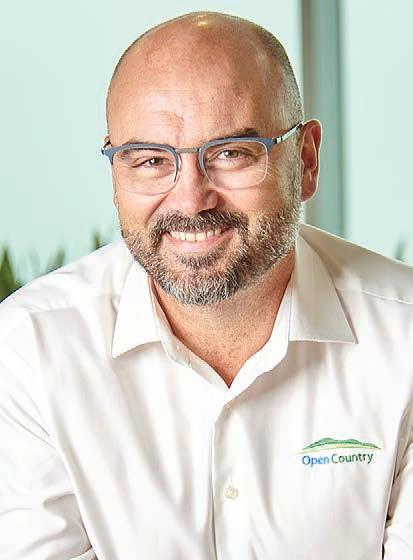
News in brief
Record trading
Listed fruit-growing and post-harvest operator Seeka has reported record trading results from its first six months of 2025. Revenue was up 8% to $307.9 million, earnings up 22% to $83.5m and net profit after tax up 121% to $37.8m. Seeka directors have lifted their net profit before tax guidance for the full financial year by $2m to $35m-$39m and have declared a 15c interim dividend to be paid on October 15.
Green means go
Green kiwifruit has become the first fresh fruit to receive an authorised health claim from the European Commission. The commission has approved the health claim that “consumption of green kiwifruit contributes to normal bowel function by increasing stool frequency” – based on a daily intake of two fresh green kiwifruit providing a minimum of 200g of flesh.
Levy vote
DairyNZ’s six-yearly vote on whether it can continue with a farmer levy will be held next year, from Monday February 16 to Friday March 13.
DairyNZ chair Tracy Brown said the levy underpins sector science, research, on-farm support and advocacy, ensuring investment in activities that are relevant to farmers now and in the future. Before the vote, the DairyNZ board and management will visit regions to meet with farmers.
Wool hits $4
Crossbred wool hit the $4 mark several times at the latest Christchurch auction sale, with well-prepared fleece in strong demand.
PGG Wrightson South Island auction manager Dave Burridge said market demand rewarded good clip preparation with improvement across most crossbred types. “We saw an excellent offering of pre-lamb shorn fleece and oddments with the wellprepared and best styles most affected and several lots exceeding 400c/kg clean.”

RMA tweak to blot up many Canty consents

Neal Wallace NEWS Regulation
GOVERNMENT changes
to the certification and auditing of freshwater farm plans could face their first test in Canterbury, where Federated Farmers says up to half the region’s farmers would otherwise require a land use consent.
Colin Hurst, national vicepresident of the federation and a Canterbury farmer, estimates up to 3000 of the region’s 6000 farmers could require a land use consent to farm without the law change. He said the legislative changes should negate the need for most of these consents.
“The belts and braces of farm plans are that they are certified and independently audited, which is like resource consents.”
Hurst said consents can cost tens if not hundreds of thousands of dollars.
Continued from page 1
The biggest barriers were cost, a reluctance to move from manual or written systems and the belief it will not provide a return on investment.
The report predicted that technology uptake would increase as new, more tech-savvy generations start running farms, people seek a better work-life balance, the shortage of skilled labour continues to bite and farmers seek to produce more from fewer animals.
Data in itself will not transform a farm’s performance, said Ryley Short, the brand manager, monitoring, for SenseHub Dairy.
“Farmers who invest in technology need to understand what it is telling them and what changes they need to make in response.”
She said cow collars and sensors
The government has introduced legislation giving authority to the minister for the environment to determine if environmental plans administered by processors and industry bodies meet the standards necessary to certify and audit freshwater farm plans.
If farmers and industry groups are already doing good work to identify and manage risks, we want to recognise that rather than force more paperwork on them.
Andrew Hoggard Associate Environment Minister
Associate Environment Minister Andrew Hoggard said it will reduce duplication of documentation, lower costs for farmers, negate the need for some resource consents and for certification and auditing by regional councils.
monitor milk production and show the ideal time for newly calved cows to go back into the milking herd, while tracking rumination rates can reveal potential issues with their diet.
Short said dairy farmers investing in technology typically begin with automatic drafters, collars or EID and then move on to animal monitoring systems.
Brian Rose, Gallagher head of animal performance and traceability, said the trend is for more precision technology to generate data and the use of AI to help interpret that information.
“It will not get to the place of telling farmers what to do but will identify trends and provide guidance.”
Increasingly the trend is to take technology to animals, such as in-paddock scales, but also to employ tech for monitoring parasite burden, animal health and parentage.

Hoggard said industry assurance programmes that could qualify include Horticulture New Zealand’s NZGAP, Fonterra’s Tiaki sustainable dairy, Synlait’s Lead with Pride and the Farm Assurance Programme Plus.
“If farmers and industry groups are already doing good work to identify and manage risks, we want to recognise that rather than force more paperwork on them.”
Farm plans will address actual farm risks and practical actions farmers can do to reduce those risks and impacts.
Hoggard gave examples of intensive winter grazing and nutrient management as farm risks that can be managed by farm plans.
“This is another step towards ensuring farmers can continue to feed the world without getting tied up in complex resource consents, and balances this with protecting the environment.”
The changes also increase the minimum size from 20ha to
These roles are improving the uptake by sheep and beef farmers.
MORE: See pages 10-12
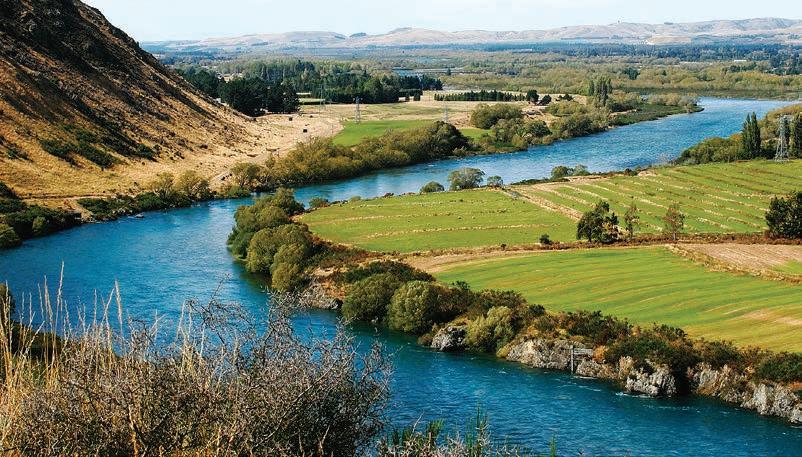
50ha of sheep and beef, arable, orcharding and viticulture farms that require a plan.
This removes the farm plan obligation for an estimated 8000 small properties, most of which are lifestyle blocks, he said.
The changes should be law next year.
Agriculture Minister Todd
McClay said this change is part of the government’s continued overhauling of the Resource Management Act to accommodate both environmental stewardship and growth.
“Farmers are already doing a huge amount of work investing in freshwater management,”
said.
Post-season lift to Fonterra milk price

Hugh
Stringleman
NEWS Dairy
This week’s poll question:
Do you think access to more technology and data tools is key to New Zealand’s farming success?
Have your say at farmersweekly.co.nz/poll
FONTERRA has increased the 2024-25 farmgate milk price forecast by 15c, to $10.15/kg milksolids, a month ahead of its financial results announcement and the finalisation of that milk price.
The latest forecast has a range of $10.10 to $10.20.
The increase will provide a welcome cashflow lift in the retro payments to farmers in September and October applying to the dairy season ended May 31.
Fonterra has also lifted its forecast range for certified organic milk from $11.70-$12.30
per kgMS to $12.30-$12.40 per kgMS.
The final organic milk price for FY25 is expected to be a record high of $12.35 per kgMS.
Chief executive Miles Hurrell said the increase in the FY25 forecast is a pleasing end to the 2025 season, ahead of the financial results due out on September 25.
“GDT prices continue to be strong, supporting the $10 forecast midpoint for the current season.
“However, it’s still early in the season and the risk of volatility remains, which is reflected in the wide forecast range.”
The FY25 forecast earnings of 65-75 cents a share remain unchanged.










McClay
COSTLY EXERCISE: Federated Farmers national vice-president and Canterbury farmer Colin Hurst says land use farm consents can cost tens if not hundreds of thousands of dollars.
Outcry prompts rethink on policing proposal

Annette Scott NEWS Community
COMMUNITY backlash has prompted a “push out” for decision
D-day on the proposed new Canterbury rural policing structure.
Canterbury District Commander Tony Hill said submissions on Canterbury Police’s redesign proposal closed on Monday, and the police are now working their way through “over 1000 pieces of feedback”.
“The engagement is really heartening, we are very grateful for all the feedback, it shows there’s very real interest in the way do our job in rural policing,” Hill said.
“We will look at our demands across the rural sector, it is important to us, in the services we provide, that we make sure all the facts are considered and there’s a reasonable amount to look through and we will need more time to do that thoroughly.
“Local police leaders need to ensure our people and resources are well organised to meet the
community’s needs and the safety of our staff.”
About 200 staff submissions and 800 submissions from the public or external parties, including some petitions, were received.
“Staff sent in very well considered, high quality feedback, and members of the public have also sent in some outstandingly articulate and thoughtful feedback which demonstrated people have taken the time to look over the proposals in detail.
The perspective is real, this is not the private sector, it most definitely is not fait accompli.
District Commander Tony Hill Canterbury
“All this feedback has been invaluable and has reinforced for me that we need to take more time with some aspects of the proposal and to keep tracking with others.”
Hill said all voices, both staff and public feedback, are now in the melting pot “to discuss what parts may not be quite right”.
“The perspective is real, this
is not the private sector, it most definitely is not fait accompli.
“I have never been involved yet in something like this where there has not been some sort of change.”
The initial decision date was August 25 and while no new date has been set, Hill said it will be several weeks before a final call is announced.
Meanwhile, Federated Farmers national vice-president Colin Hurst said farmers Canterburywide, while deeply disappointed by the proposals, welcome the extended time.
“I’m flabbergasted by what Canterbury Police wants to do to their rural police, as it’ll gut our ability to respond to rural crime and protect our people.”
Under the proposed restructure, small rural towns right across Canterbury would lose their local cops. They would be replaced by rural liaison officer positions, effectively drive-in, drive-out officers from urban centres.
Hurst said farmers already perceive police as being stretched, with the 2023 Federated Farmers rural crime survey showing nearly half of victims didn’t bother reporting crime because
Gas woes trigger $88m
Kapuni write-down
Staff reporter NEWS Energy
UNCERTAINTY over the future of gas supply has led to an $88 million write-down of Ballance Agri-Nutrients’ gas to urea plant in Taranaki, taking the shine off an otherwise solid 2025 financial result.
The fertiliser co-operative had strong underlying earnings of $38m, a 4% revenue lift to $965m as commodity prices softened, strong operating cash flows of $136m and debt reduced by $78m.
Our strong balance sheet, shareholder equity and reduced debt mean we’ve been able to absorb this one-off write-down.
Duncan Coull
Ballance Agri-Nutrients
The write-down meant it was prudent not to pay a rebate, Ballance chair Duncan Coull said.
While underlying earnings were strong, the co-operative is taking a cautious approach in writing down the Kapuni plant given the uncertainty over future gas supply agreements.
“Nonetheless we remain committed to finding a gas
supply solution for Kapuni.
Although it’s disappointing, it’s the appropriate thing to do.
“Our strong balance sheet, shareholder equity and reduced debt mean we’ve been able to absorb this one-off writedown, which is reflected by our nominal share value remaining unchanged at $9 per share.
“Most importantly, the business remains in a strong position to continue to deliver affordable and reliable nutrients for farmers and growers.”
Despite challenges during the past year, with global commodity price increases and uncertain New Zealand gas supply, Ballance’s core business continued to perform well, he said.
“This meant we could partially protect our farmers and growers from global price increases and show the strength and resilience of our co-operative.”
Ballance chief executive Kelvin Wickham said the issues with gas supply at Kapuni had taken the gloss off what had otherwise been a good year.
“It was disappointing to have that after what had been a really strong year. The balance sheet is strong enough to absorb it; we’re moving on and we really want to get onto the focus on spring.”
The co-operative was always expecting to transition off gas
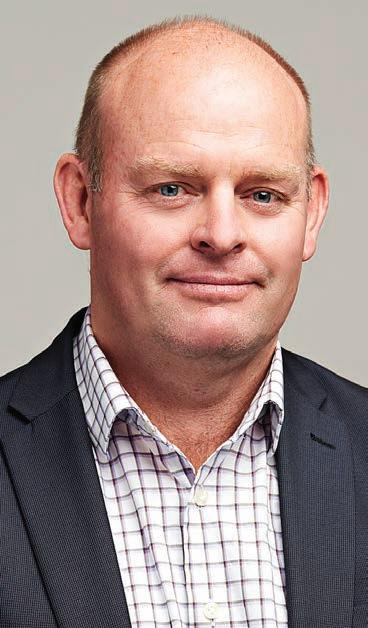
BALLANCE SHEET: The cooperative is taking a cautious approach in writing down the Kapuni plant, given the uncertainty over future gas supply agreements, Ballance chair Duncan Coull says.
but had thought this would take a decade. The uncertainty over supply has brought that forward.
He was still confident they can secure a short-term contract to secure gas but at present there was “no ink on paper”.
More information will be released in early September on securing short-term gas supply to take the plant through to January.

they didn’t believe police were resourced well enough to respond.
“So how many more crimes won’t get reported if the police service is whittled back even further?”
Hurst would like to see the
formation of a crime partnership initiative where rural community groups such as Feds and Rural Women meet regularly with police for all to keep on the same page around needs and issues in rural policing.
Flocks in holding pattern

Neal Wallace MARKETS Sheep and beef
SHEEP farmers could be waiting for another year of improved lamb prices before starting to rebuild their ewe flocks, says AgriHQ senior analyst Mel Croad.
She was commenting on Beef + Lamb NZ’s 2025 stock survey, which revealed a slowing in what have been successive sharp declines in sheep numbers.
Croad believes farmers will be cautious before increasing ewes, given the cyclical nature of lamb prices.
“They’ve seen it so often: they have a great year often followed by a notso-great year.”
BLNZ chair Kate Acland describes the survey as a “mixed bag” with overall numbers better than expected despite breeding ewes down 1.9% to 14.28 million.
The report reveals an expected spring lamb crop of 19.29 million –120,000, or 0.6%, less than last year’s 19.41 million.
Total sheep numbers were back 1%, which follows three previous years of declines of 2.3%, 3.1% and 3.2%.
The survey projects the number of beef cattle to rise 4.4% to 3.84 million as farmers opt for lower input animals.
It predicts an increase in breeding cows from 990,000 to 1.02 million and the number of beef calves expected to be born this spring to be 2.8% higher at 871,000.
Meat companies said the forecasts are broadly in line with their projections of an increase in prime
cattle, although some thought sheep numbers could have fallen further.
Croad described the 0.6% decrease in lambs as minimal and the best that could be hoped for. It provides meat companies with some certainty.
“It’s more positive than we have seen in previous years.”
Croad said the first new season sales of ewes with lambs at foot all counted have sold for $120-$125, well up on the $80 paid this time last year.
She was not surprised beef numbers had increased given international prices have been stable for several years due to global demand.
BLNZ is forecasting a 2.8% increase in beef calves and Croad said there are more dairy-beef calves being raised, both of which will increase the beef kill in the next few years.
Murray Behrent, Alliance’s manager of livestock and shareholder services, said prime beef availability will increase in coming years given a significant decline in the number of bobby calves being processed this spring.
Behrent said the year-on-year decline in bobby calves being processed in the North Island was 11.9%, and 16.4% in the South Island. In two years’ time he expects a significant increase in the number of prime cattle ready for processing.
Silver Fern Farms’ chief supply officer, Jarrod Stewart, said the company is entering the new season with confidence and the need to be flexible to match capacity to livestock flows.
He said markets and pricing are expected to remain favourable for the new season, providing farmers with much-needed confidence.
KEEN INTEREST: Waimate mayor Craig Rowley and Federated Farmers vice-president Colin Hurst addressed a packed public meeting at the Waimate Event Centre, one of several such meetings held across Canterbury in the past two weeks.
Age no barrier in premium produce market

Richard Rennie in Tokyo MARKETS Horticulture
AN aging demographic and shrinking population may not paint an encouraging picture of Japan as an export destination, but Hawke’s Bay produce company Freshco continues to see growth, margin and opportunity in the country.
With apples, buttercup or kabocha squash and cherries Freshco’s main export produce, Japan has been a long-time export customer. It is valued for its consistency and the trust built up over 35 years with Freshco’s Japanese partners.
Japan country manager Jessica Tisch said the company’s squash business, comprising 12,000 tonnes a year, tends to fly below the radar back home, given the crop’s niche nature.
“Squash is consumed quite differently to how we would eat pumpkin in NZ. It is used as an ingredient, both savoury and sweet, including cooking with a sweet sauce, or sliced in tempura, for example.”
Sixteen years ago, the company formed the Three Good Men brand for its squash marketing. Investment in the brand includes hosting retail buyers in NZ each year and working to develop retail plans.
“It has helped build a high level of trust between all parties. After an event like Gabrielle, which took out 50% of the crop, there was a lot of sympathy and understanding from our customers, and efforts to help us
Dairy farm sales take off in Canterbury

Annette Scott MARKETS Real estate
CANTERBURY dairy is on the move, clocking up 40 farm sales over the past 12 months.
On top of that, the region is on the verge of another dairy conversion boom with word of up to 30 applications being proposed.
In a Canterbury rural roundup, general manager of rural for Property Brokers Conrad Wilkshire said since the covid hiatus, high inflation, interest rates and challenging monetary policies impacting on farm costs have “pretty much rectified”.
Fonterra is also in a very strong position, with skyrocketing milk prices triggering strong market indicators and driving the boom in Canterbury dairy farm activity.
“Our winter market is well up, seeing month-on-month growth sales not only outstripping the
manage over a very tough season.”
Freshco’s apple business includes three proprietary brands, early-harvested Breeze, Sonya and Cheekie, a relatively new variety.
Japanese consumers have been very much occasion eaters for apples, consuming fruit at the end of a meal, often at the end of the day.
“The opportunity is for us to offer more eating occasions. People are looking for more convenience, like pre-chopped, pre-peeled fruit.”
The opportunity is for us to offer more eating occasions. People are looking for more convenience, like prechopped, pre-peeled fruit.
Freshco has been working closely with its in-market processing partner and the ubiquitous 7-Eleven chain in Japan to get apples processed in that way onto shelf. Its apples are now in 20,000 stores nationally, selling in convenient 80g bags for on-the-go eating.
“For us it is a win-win solution. The larger fruit are perfect for processing and because the apple is peeled, it is a great value-add sales channel.”
On shelf in Tokyo, local apples retail for NZ$3 each, compared to a Freshco offering of four for NZ$5.50, in a smaller size more suited to an older, single-dwelling demographic or families.
“Japanese growers are also facing more challenges from climate
GOLDEN EXPORT OPPORTUNITIES IN
JAPAN
change, with heat levels higher, and less winter chilling impacting on crops.”
Rather than disrupt local growing, Freshco has been working with growers to help improve their techniques in response to these challenges.
“Consumers here like to eat local, and to eat seasonally, so our work really helps to lift the entire market’s prospects,” said Tisch.
NZ apple sales to Japan have grown 60% in the past year, with Freshco having about half the market for exports here.
Japan’s tough phytosanitary standards have deterred other countries from getting a foothold, but the perseverance of NZ exporters has paid off, she said.
“The tariff level under the CPTPP is also now less than 4%. Zespri paved the way for apples to some extent, increasing consumers’ knowledge of NZ produce, and the nutrient value in our fresh fruit.”
Japan’s food retail outlets are complex and fragmented, with stores holding little stock due to space, making direct retail relationships less common, and with good distributor relationships vital for restocking.
United States retail giant Costco is a valuable customer for Freshco, with the chain’s bulk-buying focus a popular alternative means of shopping for Japanese consumers more accustomed to small, daily local buying.

same time last year but also matching the 10-year average for the number of farms sold,” Wilkshire said.
Figures obtained from Property Advisers Canterbury show 40 dairy farm sales in the past 10 months, up from just 12 in the previous 12 months and 16 in the 2022-2023 year.
“The state of the industry has not exactly been business as usual this past six months,” Wilkshire said.
“There is no question that the improved affordability of bank funding and forward confidence in the commodity cycle are playing a significant role in all this.”
Wilkshire said farmers are also increasingly confident as the regulatory settings in which their

STANDARDS: Despite Costco’s bulk buying focus, its high standards set the company up well to succeed in other markets, says Freshco’s Jessica
“It may be a bulk outlet, but it is not a discounter, placing emphasis on high quality products and a real ‘experience’ outing for members.
“Its standards are very high, and the discipline we have gained supplying them plays well into all other markets.”
Tisch said Freshco is far from daunted by Japan’s declining population.
“It is still over 120 million
ON THE UP: Figures obtained from Property Advisers Canterbury show 40 dairy farm sales in the past 10 months, up from just 12 in the previous 12 months and 16 in the 2022-2023 year.
businesses operate now appear more aligned to supporting production rather than hindering it.
The current New Zealand dairy environment is characterised by historically strong milk prices, record cow yields and a clear focus on environmental responsibility.
“Businesses need to be viable to be sustainable and that’s clearly a sign of the current times.
“I don’t believe this year is a one-off. Farms have recapitalised with investment in environmental compliance aiding value capture now, not just for sellers but also buyers who can operate on what a property can actually produce rather than competing head-on with alternative land uses or yet another policy statement limiting land use options.”
people, and many of them have yet to experience both NZ apples and squash.”
• Richard Rennie’s Meeting the Market tour has been made possible with grants from Fonterra, Silver Fern Farms, Rabobank, Zespri, Alliance Group, Meat Industry Association, Wools of NZ, Beef+Lamb NZ, NZ Merino, European Union Commission and Gallagher. https://www.farmersweekly.co.nz/ meeting-the-market/
Skellerup returns record results

Hugh Stringleman NEWS Agribusiness
SKELLERUP has announced record results across operational divisions and for revenue, earnings and net profit, enabling a 25.5c a share full financial year dividend, 50% imputed.
In the 2025 financial year ended June, revenue was up 7% to $353.5 million, earnings before interest and tax were $78m, up 7%, and net profit after tax was a record $54.5m, up 9% on FY24.

BOOTS AND ALL: Skellerup’s agricultural division, which makes rubberware for the dairy industry, achieved earnings of $35.3 million, a record result and up 15% on the previous corresponding period.
It was the ninth consecutive year of earnings growth.
The agricultural division, which makes rubberware for the dairy industry, achieved earnings of $35.3m, a record result and up 15% on the previous corresponding period.
Chief executive Graham Leaming said demand for essential consumables for the global dairy industry was consistently strong throughout FY25, in contrast to FY24, when the first half of the year was impacted by customer destocking.
This year sales in the home market were up 6% and in international markets were up 10%.
“Over the past 18 months, we have successfully launched new high-performance milking liners in the [United States] market and the first products from our Thriver calf feeding range into NZ and international markets.”
The industrial division had earnings of $48.4m, a fifth consecutive record result.
Skellerup said it has a very strong balance sheet with minimal debt and is looking at in-market capability and plans for the additional capacity at existing plants.
Tisch, left, pictured with Japan marketing manager Susie Krieble.
Photo: Richard Rennie
Jessica Tisch Freshco, Japan
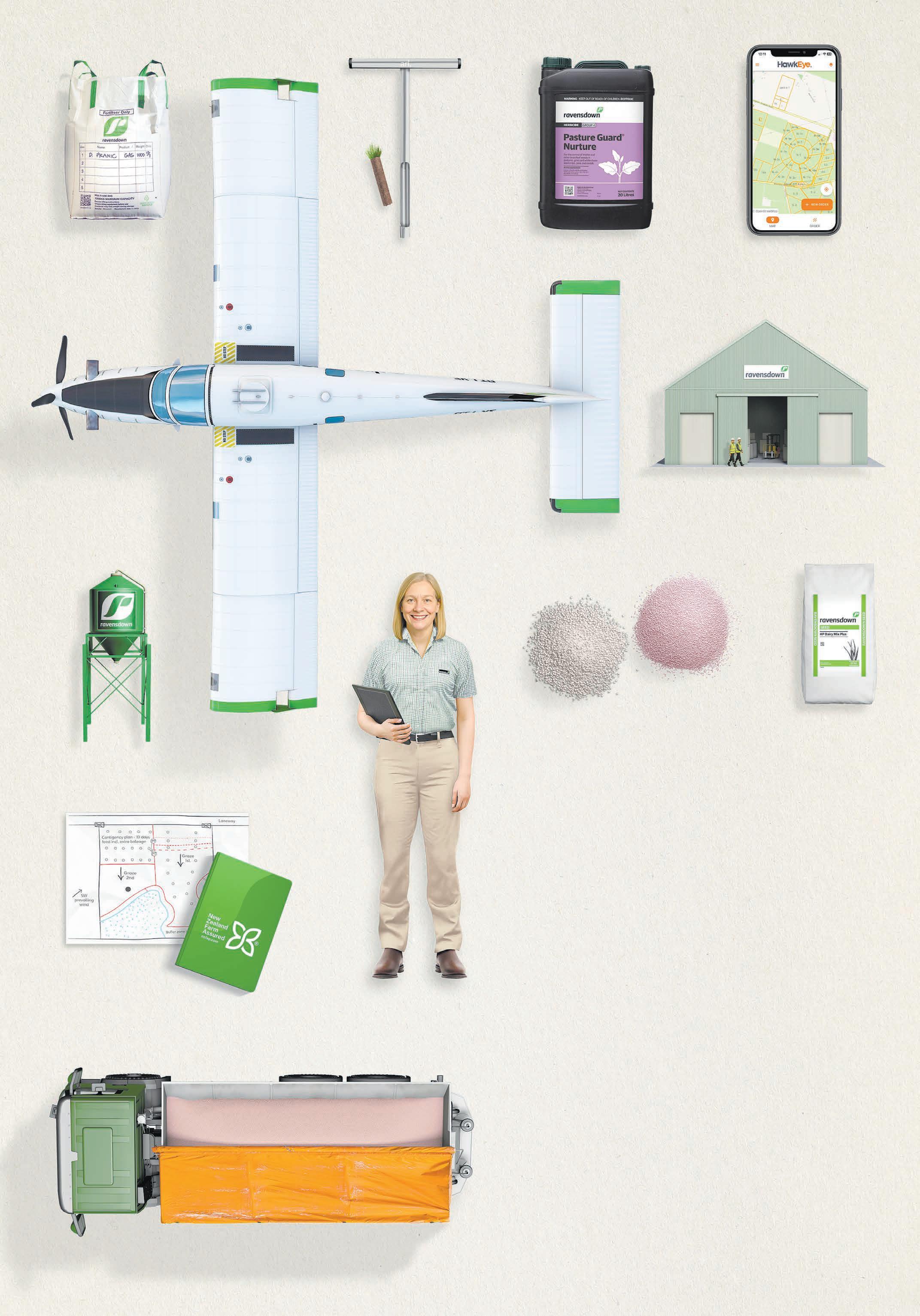

Everything you need for spring . Only from Ravensdown.
















G et ting spring right is crucial to your farm’s succe s s With Rave nsdown, you’ll get eve r y thing from agronomy advice to top - qualit y nutrie nt s and te ch to ols like HawkEye. We’re the complete package, g uiding eve r y de cision and delive ring m ore from your inve stm e nt.


G et s p ring rig ht . C all 0800 100 12 3 o r t alk to your A g ri Manage r to day.
Dawn Meats plays up Alliance synergies

ALLIANCE Group joining forces with Dawn Meats would enable yearround supplies of red meat to global markets, says the head of the Irish company seeking to buy 65% of the New Zealand farmer-owned co-operative.
In a letter to Alliance shareholders, Dawn Meats chief executive Niall Browne says both companies process quality, grass-fed meat, and the opposite seasonal production would allow for year-round supply.
Dawn Meats has strength in beef, selling predominantly into markets in the United Kingdom and Europe, and Browne believes NZ beef could achieve the same favourable status with consumers in those markets as NZ lamb.
Alliance’s strength is in lamb production and markets in the UK, Europe, Asia, China and North America.

“Meanwhile, Dawn Meats would benefit from greater access to North American and Asian markets,” Browne said. New or improved free trade agreements have opened access for NZ meat exports to the United Arab Emirates, as have regional agreements with multiple Asian and Pacific countries and bilateral trade deals with Thailand,
Singapore, Hong Kong, Taiwan, South Korea and Malaysia.
Dawn Meats is offering $250 million for a 65% stake in Alliance, with shareholders to vote on October 20 on whether to accept the offer.
Given NZ’s free trade agreements
Wool Impact granted extension

Annette Scott WOOL Food and fibre
WOOL Impact, the entity tasked with driving export growth for the New Zealand strong wool sector, has been extended a lifeline on its initial three-year runway to get projects off the ground and in operation.
In July 2022, the government invested $4.5 million to back the new venture. Under new industry body Wool Impact, the $11.4m programme was designed to facilitate innovation and support growth to enable a unified voice for strong wool in NZ while growing existing and generating new demand for strong wool consumer brands, products and services.
Wool Impact is a collaboration between the government and industry sector partners under the Sustainable Food and Fibre Futures (SFFF) fund.
The three-year programme, designed to last until June 30 2025, included sector partners WoolWorks and sheepmeat
processing entities contributing $6.9m on top of the government’s $4.5m investment.
“It’s been a three-year sprint, we have evolved as an organisation with knowledge and maturity.
Wool Impact will remain active for the next 12-24 months to build on initiatives currently underway,”
Wool Impact chief executive Andy Caughey said.
“This will enable Wool Impact to continue to develop new demand for NZ strong wool and support the sector in converting demand into higher prices for woolgrowers.”
At the same time, Caughey said, Wool Impact will advance the development of an enduring model for the sector in partnership with Campaign for Wool and the Wool Research Organisation of NZ (WRONZ).
“We are playing catch-up on 20 years of underinvestment in wool support services so what we are trying to achieve takes time and effort.
“Progress is being made and this work will need to continue in some form if we want to deliver
sustained improvements for strong wool.”
With the end of the initial three years, several board appointments and roles came to an end.
“We now have a fittingly lean board” comprising chair Stuart Heal, Nick Aubrey, Steve Penno and Mike Stephens, both from the Ministry for Primary Industries.
There is also an expanding governance responsibility through the collective partnership with Campaign for Wool and WRONZ.
Funding remains the same, meantime on a “stretched out budget,” with expectation of announcing new funding partners in the coming months.
Caughey said that included in the wide range of work in the three years to date has been brand and value change engagement and support both domestically and internationally, alongside innovation enablement.
“Brand connectivity has been our main focus on developing greater connection with brands and influencers of demand and value for wool products and our wool.”
Looking ahead, Wool Impact
with the UK and European Union, Browne said, joining Dawn Meats would give Alliance greater access to blue chip customers in both regions.
“It would also allow for the sharing of expertise, operational practices, insights and innovations,” he said.
Founded in County Waterford in Ireland in 1980 by three farming families, Dawn Meats has grown to become one of Europe’s most significant red meat processors. It operates as Dawn Meats in Ireland and as Dunbia, through a subsidiary company, in the UK.
Browne said the company has the same approach to each new acquisition.
“Our approach is to continue to develop and protect the heritage of any business we partner with or acquire, achieving growth through further innovation and advanced processing and logistics operations.”
In 2017 it entered a joint venture with the UK company Dunbia, which was driven by the need to remain competitive, particularly in light of Brexit.
In 2023 it acquired Kildare
It would also allow for the sharing of expertise, operational practices, insights and innovations.
Niall Browne Dawn Meats
Chilling, a lamb and beef processing business in Ireland, into which it has invested NZ$20m.
This financial year Dawn Meats will generate revenue of nearly NZ$6 billion.
It employs more than 8000 staff in 10 countries, operating 11 sites in Ireland and 13 in the UK. These include four retail packing facilities producing fresh, frozen, value-added and cooked retail and foodservice packs, and two frozen burger facilities, one of which is dedicated to supplying McDonald’s.
Each year it processes about 1 million cattle and 3.5 million sheep for supermarkets, foodservice and manufacturing businesses in more than 50 countries.

remains focused on three key outcomes – demand, value and leadership.
“This is about developing opportunities with brands new to wool as well as supporting growth of brands currently using wool.
“Global reporting requirements need traceability. This supports more direct sales mechanisms and more transparency through value chains. We’re enabling this.”
Several grower field days are in the planning, kicking off in Southland and Otago on August 27 and 28.
“Wool Impact was set up for the benefit of our wool growers. We need them to be involved, and that includes anyone who wants to see sheep farming prosper so farmers can invest in sustainability of their land and the vibrancy of their communities.”
Price index steady as GDT spreads the demand

RESILIENCE: Mozzarella was down 2.7% in the latest Global Dairy Trade auction.

Hugh Stringleman MARKETS Dairy
DEMAND resilience in some regions of the world is keeping Global Dairy Trade auction prices stable ahead of the New Zealand spring surge in milk production.
In the latest GDT auction the overall price index dropped 0.3% but whole milk powder prices were up 0.3% and anhydrous milk fat was up 0.1%.
Prices for the other commodities
were down across the board –mozzarella minus 2.7%, skim milk powder minus 1.8%, butter minus 1% and cheddar down 0.5%.
None of these negative components, nor their sum, were enough to counteract the WMP lift and push the GDT index into negative territory.
NZX head of dairy insights Cristina Alvarado said the resilience of demand is notable given the growing availability of dairy products from NZ, the United States and Europe.
“With softer prices, ongoing tariff discussions, and varying regional buying patterns, the market has so far managed to absorb higher product offerings without significant downward pressure,” she said.
Regional demand shifts included the Middle East growing to 14% compared with 9% in the previous auction, and more purchasing from Europe and Central and South America, to help balance the market and counter the fall from China, down from 43% to 34%.
Neal Wallace NEWS Production
ALL YEAR: Dawn Meats chief executive Niall Browne says Alliance Group and Dawn Meats together could achieve year-round supplies of red meat to global markets.
WOOL GATHERING: Andy Caughey, seated left, says wool will only contribute meaningful profit to NZ sheep farming systems if industry works together.
A2 Milk Co kicks its cans down the road

THE spate of buying and selling of milk processing plants by
The a2 Milk Company is critical to expand its China-label infant formula product range and de-risk and diversify, according to equity analysts.
Mataura Valley Milk in Southland will be sold to Open Country and the Yashili plant in Pōkeno, south Auckland, purchased, along with its Chinese product registrations that could be converted to a2.
The crucial milk supply with a2 beta casein protein and not the a1/a2 combination found in regular milk has been secured from Fonterra in the upper North Island.
“We view this as strategically and financially sound,” Forsyth Barr analysts Matt Montgomerie and Ben Crozier said.
The three apparent benefits are vertical integration and margin gain, access to new Chinalabel products, and the exit
from the loss-making Mataura Valley.
Craigs Investment Partners also noted the improvement in marriage data in China from which higher birth rates are expected from 2026 onwards.
South Island a2 milk processor
Synlait, a 20% subsidiary of The a2 Milk Company (ATM), said it is in discussions with a party regarding its Pōkeno plant, alongside that of Yashili, but discussions are incomplete, no binding terms are signed and there is no certainty a transaction will occur.
We view this as strategically and financially sound.
Synlait said it would not respond to further media speculation about the possible sale of Pōkeno. That speculation mentioned multinational Abbott Laboratories, already a non-dairy processing customer at Pōkeno.

ATM said it will invest up to $500 million to buy the Pokeno plant for $282m, conditional on the Chinese registrations being transferred, $100m in capex to expand production and $120m in additional working capital and product development.
Its sale of 75%-owned Mataura Valley will net $100m.
ATM has also announced an intention to pay a special dividend of $300m upon the successful completion of these plant moves and product registrations, which would be about 40c a share.
Nearing 25 years old, having been established by founder Dr Corran McLachlan on the controversial thesis that a2 beta proteins in milk are healthier than a1, ATM only began paying a 20c dividend for the first time in FY25.
It has a very strong balance sheet, with cash reserves over $1 billion before the transactions just announced.
Now some 20% of all infant formula sales in China are a2 products and that segment of the market grew 12% in FY25, the company said.
ATM has the fourth largest infant formula sales value share in China, being 8% of the total market, and this is forecast to improve to 10% over the coming five years.
Its revenue in FY25 was $1.9bn, of which $1.3bn came from China and other Asian markets, $316m from Australia and New Zealand, $140m from the United States and $144m from Mataura Valley.
Liquid milk accounted for $346m of sales, in ANZ and the US, and $1.274bn from infant formula.
The ATM share price has risen 40% over the past six months to sit around $9.20 presently, but still well below its speculative peak pre-covid.
MORE: See page 16

SOUTHERN EXPOSURE: Open Country CEO Mark de Lautour says the purchase will give the ability to commit further to the Southland and south Otago regions.
Open Country to acquire Mataura
Valley Milk
THE country’s second largest dairy company, Open Country, has entered into a conditional agreement with Mataura Valley Milk’s shareholders to acquire the business.
Mataura Valley Milk is located near Gore and is majority-owned by The a2 Milk Company alongside its minority partner, China Animal Husbandry Group.
The acquisition would give the company the ability to commit further to the Southland and south Otago regions, Open Country CEO Mark de Lautour said.
“The deep south is an important region for Open Country and is an area we have previously announced as targeted for significant capital investment.
“This site is a strategic investment for Open Country given its advanced, high-tech design.
“Its capabilities give us the opportunity to produce a different array of higher value products that will complement our current Awarua site product range.”
Open Country currently has six production sites across New Zealand and a head office location in Auckland.
The agreement includes a supply arrangement with The a2 Milk Company whereby the Mataura Valley Milk site will continue processing A1 protein-free milk to produce A1 protein-free milk powder.
Milk supply agreements with current farmer suppliers remain unchanged.
“We look forward to working with the team at Mataura Valley Milk to fully utilise the site’s capability. In doing so, there will be an exciting opportunity for new farmers to add to the existing supply group and join the wider Open Country family of farmer suppliers,” he said.
De Lautour and Open Country’s board chair, Laurie Margrain, will join The a2 Milk Company CEO David Bortolussi to meet with Mataura Valley Milk staff and current farmer suppliers on August 26.
“At Open Country we are focused on ensuring we are in a position to provide dairy farmers with genuine choice – choice that benefits farmers, our staff and the New Zealand dairy industry as a whole.
“This has flow-on benefits to the New Zealand economy and the communities in which we operate given our 100% New Zealand ownership,” De Lautour said.


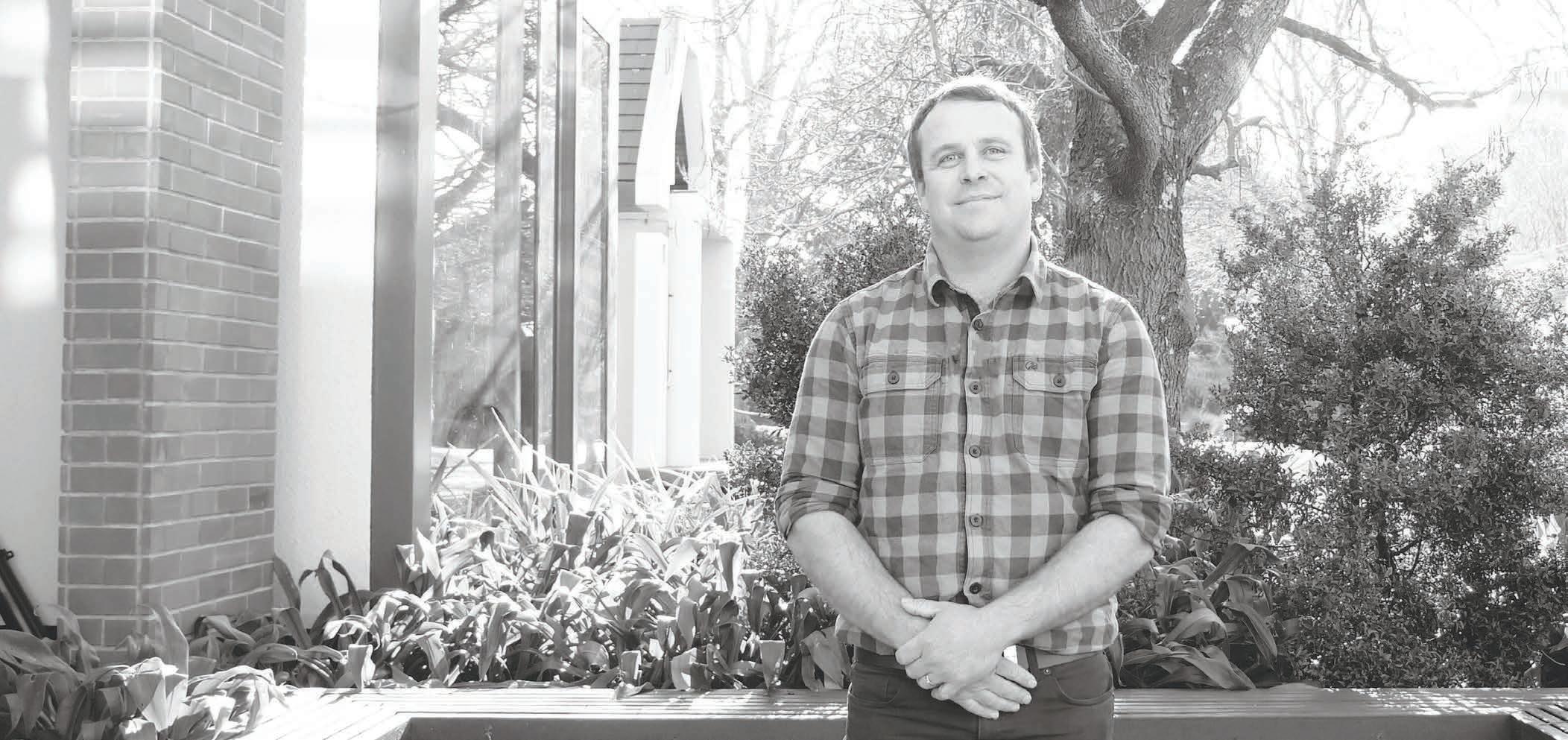

Hugh Stringleman NEWS Dairy
Matt Montgomerie and Ben Crozier Forsyth Barr
SPECULATE: Synlait says it will not respond to further media speculation about the possible sale of Pōkeno.
Dairy Goat Co-operative sets out new strategy

THE Dairy Goat Co operative is embarking on a new strategy based on growing its infant formula range, and embarking on a capital raise where it seeks $40 million from investors.
The Hamilton-based company set out the strategy to its 50 farmer-shareholders in May as a way of climbing its way out of the severe financial issues it faced during and after the covid-19 pandemic.
In the year prior to the pandemic, around 55-60% of the co-op’s sales were in China, and half of them came from the Daigou channel.
That market disappeared when borders were shut during covid. Compounding the issue was that the co-op then failed its SAMR registration in 2022-2023, which is required to export infant formula to China.
That shut down the remaining access to that market for the Dairy Goat Co-operative (DGC).
“Between those two events, which happened in the course of
LIFT: Cans of infant formula powder on the process line at the Dairy Goat Cooperative’s factory in Hamilton. The factory is currently running at 50-60% capacity but CEO Alastair Hulbert wants that lifted to 90%.
two and a half and three years, we lost all of our infant formula sales,” DGC CEO Alastair Hulbert said.
At the same time, it continued to collect and convert goat milk into powder, which built up its inventories. At its peak, the co-op had around 23 months’ worth of powder.
The farmers were paid for this milk, meaning DGC had the corresponding debt on its balance sheet.
We need to be very commercially focused and focused on our markets. We’re open for business and the doors are open.
Alastair Hulbert Dairy Goat Co-operative
Compounding this was that many farmers during the 20162019 boom years had expanded their farms and were carrying high debt levels.
The payout to farmers dropped and it all put the co-op and farmers in an extremely dire economic position.

“It was almost the perfect storm,” Hulbert said.
It triggered changes within the DGC. Rene Burri was appointed DGC chair and Hulbert CEO in May last year.
The new leadership also forced a company culture change. Its reputation of being an insular and extremely private company could no longer work if it wanted to tell its story in the export market, he said.
“We need to be very commercially focused and focused on our markets. We need to collaborate with other people in the industry both within the goat industry and sheep milking.
“We’re open for business and the doors are open.”
To reduce its inventory, DGC started selling its powder as a whole milk powder ingredient into China, which did not require a SAMR certification. This enabled the co-op to pay off $18m of debt last year.
It also lifted the payout for farmers by 35% for the June 2024May 2025 season.
The forecast for the new season is $12.50-$14.50/kg MS. Excluding debt servicing, the average DGC farmer’s operating expenses sit around $12/kg MS.
On the back of the new strategy, there is a degree of optimism for the future among the farmershareholders. It has also given them clarity its future.
“It’s not going to be an overnight fix. It’s going to be two to three years of grind to get through it.”
Focusing on infant formula provided the DGC the best growth avenue and returns for its farmers, allowing it to get back to what it is best at, Hulbert said.
“We have an immediate focus on getting farmer returns up and the real focus for the next five years needs to be on infant formula.”
It is a high-value product that sits in the premium end of the

market and there are good margins to be had.
Supporting that is better asset utilisation at DGC’s plant in Hamilton. The factory is currently running at 50-60% capacity.
Hulbert wants that lifted to 90% and this process is already underway.
“We need to fill the factory up because it helps the overheads and that in turn increases returns to farmers.”
Third-party contract manufacturing and continuing with ingredients sales are lifting that utilisation.
A dual payment system for its farmers has been introduced. One is an entitlement based on a farmers’ shares that reflects the value given for infant formula.
The other is WMP sales, in terms of which farmers receive a commodity milk payment – a fixed price payment for a set volume of milk that is around 30% lower than the infant formula payment.
As infant formula sales grow over time, it is hoped that the ingredients payments will decline as farmers chase higher value, he said.
Critical to the strategy’s success is returning to the Chinese infant formula market in 20282029 because renewing a SAMR registration is a $15m, three-year process.
China aside, the co-op also wants to build market share in its existing markets and build its presence in emerging markets such as Mexico, Vietnam and Canada, among the 23 countries it sends its products to.
Hulbert also has eyes on the United States market despite the prospect of paying a 31% tariff. It also requires completing a US$4m FDA approved clinical trial on babies, which takes 18 months to complete.
Being at the premium end of the market means it can absorb the tariff and still make a profit.
Driving that growth in those two key markets required extra capital which was why the DGC has embarked on the capital raise, which began in May.
Hulbert was tightlipped about it, citing confidentiality, apart from saying DGC is targeting strategic investors and it is a 12-month process.
He is optimistic about the future in spite of the recent struggles the co-op has faced. DGC has a great product that is backed by science and in demand from consumers, he said.
“We have a great story to tell. We invented infant formula from goat’s milk. The foundations for the future of the industry are really exciting.”
Pride in their work drives rural contractors

Annette Scott NEWS Agribusiness
RURAL contractors are a key cog in driving efficiencies across the agricultural sector, according to Lincoln University researchers. They say contractors are an essential part of the rural economy, growing in importance, offering farmers greater efficiencies through their specialist skills.
Yet, despite their importance, there’s been little formal research into this sector.
While some might think external factors such as competition are the main drivers affecting a rural contractor’s business, this is not the case, according to the contrac tors themselves, the researchers say.
“Instead, operational excellence,
their commitment and knowledge to do a job well is what they believe drives success most, with effective and efficient management and delivery of services to farmers as most critical,” said Dan Smith, co-author of the report Small Rural Farm‑Support Agribusiness: Strategies to survive and thrive.
Twelve Canterbury rural contractors specialising in hay baling, fertiliser application, fencing, spraying and cultivation were interviewed with Canterbury chosen as it contains most land uses present in New Zealand, including dairy farming, sheep and beef farming, arable and forestry, spread over differing soil types and geography.
“The challenges I identified through this research included input costs, seasonality and the time pressures associated with
an owner-manager having to be across all aspects of the business,”
Smith said.
“Plus, rural contractors often need to operate expensive,
specialised assets and machinery, which accrue both debt and the need for constant maintenance.”
To help counter these challenges,
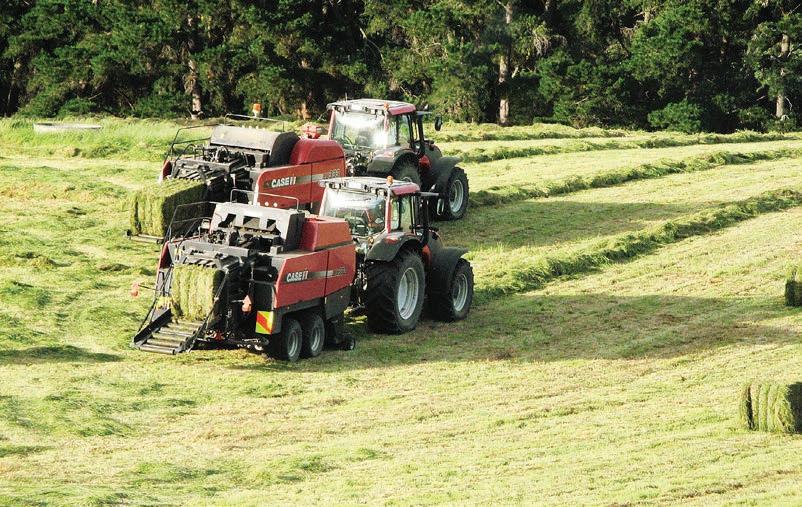
Smith said, rural contractors look to mitigate risks through specialisation, which can help manage the seasonality of many on-farm tasks.
If a contractor has one specialisation, they are most focused on forming positive relationships with farmers, their staff and extending into the community.
“Those with more than one specialisation care most about operational excellence while the largest businesses, with five or more staff, placed the greatest focus on the care and maintenance of their assets.
“So, the size of the business, and if they specialised in one or more activities, dictates their greatest priorities.
“The good news is that the majority of those interviewed reported low stress levels.”
NANNY STATE: Dairy Goat Co-operative CEO Alastair Hulbert says the focus on dairy goat infant formula provides DGC with the best growth avenue and returns for its farmers, allowing it to get back to what it is best at.
SKILLED: The researchers shining a light on rural contractors suggest they are an essential part of the rural economy, growing in importance, offering farmers greater efficiencies through their specialist skills.
Gerald Piddock NEWS Dairy
Farming with Data
Getting data input to serve farm output

Richard Rennie TECHNOLOGY Agriculture
LIZ Muller and Jeremy Bryant oversee two businesses at the sharp end of data generation on farms, producing millions of kilobytes of data points that, when managed properly, can help farmers make better choices.
Bryant’s start-up company, Aimer, enables farmers to use their smart phone to video pasture, creating images that can be used to deliver cover estimates, feed wedges and grazing plans for their next rotation. Muller’s company, Herd-i, scans cows to determine body condition score, using artificial intelligence (AI) to track changes over time.
Muller said it is the “mashing” together of multiple data sources that will deliver farmers more highly valued decision-making options in years to come.
Taking multiple sets of farm, weather, animal and financial data will mean tricky, vital decisions such as when to dry off are made with no money left on the table that season, while not robbing any from the next.
“This is all on our future
pathway, but we are not there yet,” she said.
“There is still an element there now on questioning ‘What do I do with this data?’, on turning it into meaningful insights.”
She also notes there remains a gap between farmers taking the data at hand and trusting AI to do something meaningful with it for them.
“Some may trust it, but many won’t.”
Bryant cautions that farmers risk entering a period where “a lot of data is there, but it is just noise to them”.
“There’s really a need there to get these tools that take that data and say ‘Okay, what do I need to do over the next week, or two weeks, to transform things?”
He said it requires a finely nuanced system to accommodate the dozens of small on-farm decisions farmers make every day that cumulatively are worth thousands of dollars a year in gained or lost income.
“And of course the decision to do nothing over two to three days at prime periods like spring, that can cost thousands.
“And they want to measure in a way that is cost effective, they do not want x hardware leading to y

DECISIONS: Liz Muller, CEO of
says ultimately the multiple data streams companies like hers generate will be threaded together for farmers to make actionable decisions quicker.
There’s really a need to get these tools that take that data and say ‘Okay, what do I need to do over the next week, or two weeks, to transform things?’
Jeremy Bryant Aimer
cost. This is why we’ve lent into the smart phone – everyone has one, and it’s always on hand.”
He said there has been good work done in interoperability between different data gathering companies in recent years.
“But the question is now ‘Where to from here?’”
He sees the next step being to link animal data to farm data, effectively creating the farm’s “digital twin”. This is now a reality with greater use of wearables on cows by farmers.
“We are focusing on alignment with other data gatherers. There is no reason why everyone needs to be a master of everything.”
Early integration work his company has done includes taking a farmer using Allflex collars and linking it with Aimer pasture data.
“You get heat, health detection, and information on rumination and paring, while Aimer manages the pasture side on available feed allocation to match this.”
Rather than “one platform to rule them all”, Bryant believes tech platforms are better
positioned being agnostic to the hardware they pair with as deeper communications between equipment becomes possible.
“Working with other companies will see some problems solved quicker than trying to do it yourself. Collaboration can be challenging as a business, but it is a better way to work.”
Possible next steps include “AI agents” working for farmers. This is tech that works within specific data sources, rather than casting itself into the entire internet as its data source.
“Rather than learning from the internet, it is aware of your data sources. It keeps data secure and removes that impact of open AI that incorporates biases and uses sources not as relevant to NZ pastoral farming.”
Farm data revolution comes with a ‘but’

Richard Rennie TECHNOLOGY Agriculture
WELL into his second decade dealing with electronic farm data, Tony Walters says he is circumspect about New Zealand’s promised farm data revolution.
Walters and his wife Marlene dairy farm near Waiuku, South Auckland, and were crash test dummies for the likes of Fonterra and Spark in the early days of remote data sensing and transmission.
“We were the first farmers in NZ to have a 3G modem for broadband when our cell tower was upgraded,” Walters said.
Following this came a “LoRaWAN” network, a low range comm system that enabled the (then) emerging Internet of Things (IoT) technology, where remote sensors could communicate via the web.
His on-farm sensor network extended to a weather station, soil/milk temperatures, and water tank levels.
“They were just trying to see where the tech could be taken, trialling all sorts of stuff.
Unfortunately, covid saw it get knocked on the head.”
Today, though, the Walters have doubled down on their data gathering, having put Irish Dairy
Master brand wearable collars on their herd four years ago.
He picked up the equipment from a Northland farm that failed to integrate it effectively, and sold

it to him at a significant discount.
He continues to monitor and download weather data collected through his Harvest Electronics remote weather system.
“But what has surprised me is how long it has taken to be able to integrate data. We were talking to Fonterra about this back in the early 2000s, about allowing it into your farm diary. But it’s only just happening now in 2025, and we still can’t put our weather data in.”
He believes there has been too much squabbling between companies on who owns farmers’ data, and how it will be shared.
He said this has prevented farmer customers from getting the full benefit of data they generate.
“FarmiQ was going to be the perfect tool to have taken data further to integrate, but it did not seem to get there.”
But despite this he has found benefits having the herd on wearable tech and would not be without it.
Two years ago a poor mating period was able to be traced back using the wearable data to a shift in the herd’s rumination pattern, caused by a sudden change in diet.
“Our local vets, Franklin Vets, are
in the process of working out how they will use this data for farmers, sitting down to help identify problems the wearable data alerts them to.”
He cautions though the tech is not infallible.
“It will only be as good as the data, like calving dates, you put into it.”
But what has surprised me is how long it has taken to be able to integrate data.
Tony Walters Waiuku
For Walters the single biggest advance has been having 4G connectivity at the farm dairy to enter cow data as it comes in and not having to do it at home at night.
“But I am a bit disappointed overall on where things are at.
“We do have better connectivity but data usability still lags, and industry has not sorted out data ownership and that common platform.”
Herd-i,
SHARE: Tony Walters believes there has been too much squabbling between companies on who owns farmers’ data, and how it will be shared.
Photo: Richard Rennie
Wearable hardware a data driver

Richard Rennie TECHNOLOGY Data
COW wearables are the main generators of the surge in farm data with New Zealand dairy farmers investing significantly more in them in recent years.
A DairyNZ survey conducted in 2023 found farmers with rotary dairies were the biggest investors, with a 24% increase in the number of herds wearing the technology since 2018.
This took the total number of herds then to 16% of all farms, but industry estimates today have the adoption rate even higher, at about a third of all herds.
Based on the survey, collars have proven the most popular, accounting for 80% of the tech, with ear tags the rest.
Since the DairyNZ survey, the wearable sector has had a significant lift in awareness, largely off the back of high-profile products like the Halter tech and

Gallagher’s eShepherd that have gained attention with their “virtual paddock” mapping tech.
Jeremy Bryant, founder of Aimer pasture-estimating technology, told Farmers Weekly farmers are also becoming more discerning about the tech available.
“A number have said they can get the likes of Aimer and a wearable
Facial recognition tech trialled in sheep

Neal Wallace TECHNOLOGY Sheep and beef
A TRIAL using facial recognition technology on sheep shows it could have a role in monitoring their performance, says Paul Crick.
The Wairarapa farmer says it could potentially be a costeffective way to improve per-head production.
Facial recognition technology on farm is still at a trial stage and involves a camera photographing the face of individual sheep prior to it being weighed.
This provides a quick record of their identity so that new and updated information such as weight
can be subsequently added and stored.
Crick also uses EID tags in his sheep but said if facial recognition were sufficiently accurate, it could be a cost-effective alternative.
Very early trials show its accuracy is currently above 50%.
He was recently involved in trial for a worm app that highlighted the benefits of identifying individual sheep.
The app was linked to weighing scales and had algorithms that recorded information such as egg counts and weight gain, which he used to make management decisions.
Crick said that information became the basis of a drench
NUMERATED:
Wearable hardware is generating more data for dairy farmers, but more remains to be done to better understand and integrate that data into farm decisionmaking.
at 20% of the cost of virtual fencing tech, and being happy to work with that.”
Heat detection for mating proved by far the main reason for employing the tech, with some interest in health monitoring and virtual paddock use.
Wearables also featured high on the list for farmers with rotary and herringbone sheds, as the most
preferred investment to make, funds allowing.
Work by DairyNZ senior scientist Paul Edwards took a deeper dive into outcomes from wearable tech on breeding decisions made by farmers. Analysing data from 141 herds with wearables and 1150 without, comparisons were made on three-week submission rates, and six-week calving rates between the two herd types.
Interestingly, the results indicated that while the tech is a valuable labour-saving device, it is not necessarily a magic bullet solution to lifting a herd’s repro performance.
Lower performing herds showed no repro performance gains after adopting wearables.
However, the tech did allow for longer artificial breeding periods and wearable herds had a lower non-return rate after the tech’s adoption, possibly because they had longer AM periods that were made easier with the tech’s presence.
But after accounting for mating

trial in his ewe lambs and to determine which of three mobs they were put into – control,
no drench and drenched.
Over a four- to five-month period, the mob that were not
A number have said they can get the likes of Aimer and a wearable at 20% of the cost of virtual fencing tech.
Jeremy Bryant Aimer
length, there was no statistically significant difference.
The report’s authors noted future use of wearables may extend beyond reproduction to include more indvidualised animal management including grazing, while future outcomes may improve as farmers better understand how to use data from wearable systems effectively.
They cautioned that, given the lack of significant positive or negative evidence on in-calf rates, it was advisable not to place value on improved repro performance when assessing return on the tech investment.
drenched continued to grow and saved him $2.70/head over the control mob.
He said technology enabling the quick and affordable monitoring of body condition scores in sheep could potentially have commercial benefit.
Research shows ewes with a body condition score of three prior to lambing but which subsequently reduced by 0.5 or one body condition score from lambing to pre-mating, are the most productive.
Crick said the size and scale of most sheep flocks mean individually identifying those that are the most productive can be daunting and require a change in mindset.
But tailoring the management to use these high-performing ewes can financially be very rewarding. Last spring his best performing sheep, identified by body score, lambed at 172% ewes mated.

FACE TIME: Wairarapa farmer Paul Crick was recently involved in trial for a worm app that highlighted the benefits of identifying individual sheep.
Bring farmers data tech they can actually use

Neal Wallace TECHNOLOGY Agriculture
HO is a farmer?
WThe answer, according to Danny Donaghy, Massey University’s professor of dairy production systems, is not as clear as it may appear – and answering it is relevant for technology developers.
Is a farmer the owner, manager, second in charge, herd or block manager, farm staff, vet, adviser or, in a corporate structure, the board or their consultant?
Donaghy said the other question developers need to answer is who needs what information and in what form.
He said there are plenty of tools being developed, but to be useful they need to talk to each other to avoid the need for multiple dashboards or phone apps.
Some welcome the volume of data supplied to these devices, but other feel overwhelmed.
A study on data use by Australian dairy farmers some 15 years
ago found many were turned off.
“All they wanted were cup removers or automatic teat sprayers, whatever would save them time.”
The message was that farmers want technology that saves time, effort and money, such as enabling the precision application of fertiliser.
While technology and the information provided have evolved, Donaghy said tech developers need to ensure it is relevant and useful to the bulk of farmers.
It keeps coming back to who needs what information, in what format and when?
Prof Danny Donaghy Massey University
“It keeps coming back to who needs what information, in what format and when?”
As for areas where technology would make a significant difference, Donaghy said these
would involve the measuring and allocating of pasture, crops and fruit, monitoring animal health and wellbeing and integrating sensors for the management of soil and water.
Such technology could be applicable to monitor yields for arable, winter feed and horticultural crops.
Manually monitoring soil and water condition is time consuming, so having sensors that talk to each other would simplify the process, give real-time results and in a format that could be provided to regulators.
AgFirst chief executive James Allen said farmers need to be clear on what problem they are trying to solve, what tool is needed to solve it and how that tool can be best used.
Allen said there is potential for farmers to be overwhelmed by the volume of data, but it will be key for adopting precision agricultural systems.
“If we want precision farming we will need to farm on a per-square metre and per-animal basis and that means using a lot of data.”

REWARDS: Danny Donaghy says a study on data use showed farmers want technology that saves time, effort and money.
He said specific soil fertility and pasture production information will have a significant role in farm management.
A farm growing an average of 12 tonnes of drymatter per hectare would have a range over the property of eight to 20 t/DM/ ha, so data will allow focused management.
Equally, it would be useful having real-time alerts that an animal has health issues before symptoms became obvious, or the ability to decide grazing patterns
by the current state of soil or vegetation.
There is potential for farmers to be overwhelmed and his challenge to developers is to ensure it provides relevant data insights.
Allen said there is a greater willingness among IT companies to share data and systems but it will not happen quickly or without a cost.
He said returns from using data may not be financial, but from greater animal or plant efficiency or saved time.
Tech easing the chore of on-farm data entry
Richard Rennie and Neal Wallace TECHNOLOGY
Data
FONTERRA is doubling down on its goal of halving the time its supplier shareholders spend wading through data entry chores, hoping to hit that target in a year’s time.
Hayley Morris, Fonterra’s business transformation digital lead, said based on a DairyNZ workplace productivity survey, farmers have been spending about five hours a week on compliance recording, generating a lot of negative sentiment.
To date, Fonterra has saved its suppliers 507,000 hours a year in input time, halfway towards the target of 1 million hours saved. Farmer data is needed to satisfy
growing requirements from customers and regulators for transparency and assurance of the product source and supply chain security.
Morris said two main target areas had been identified as key pain points.
“The on-farm audit is now at a point where we are the only dairy processor not requiring a full assessment if you have a strong track record of quality data, assessment performance and milk quality.”
The other area is the annual farm diary records that require key farm activities including animal treatments, fertiliser and feed inputs to be logged.
Waiuku farmer and long-time data user Tony Walters told Farmers Weekly he had found the diary system clunky when it
came to entering data like PKE deliveries, requiring a photo of the delivery docket to be taken, and in turn uploaded to the diary.
“And we only get an update of all activities at the end of the season, so you can’t use that useful information through the season.”
Morris said to make data more seamless and updated more regularly, Fonterra has built data partnerships with the likes of Ravensdown, CRV, LIC and Ballance, and also recently integrated with Trev and FarmIQ systems.
Ultimately, she said, farmers won’t have to update their data manually, instead most data collection will simply be automated in the background as events occur.
“We are at a stage where industry is now more united when it comes to data sharing.”

PARENTAGE: Animal parentage can be proven from a simple skin test, said Totogen co-founder Tim Hore.
TESTS: Skin tests awaiting analysis to determine parentage lines at Totogen’s Dunedin lab.
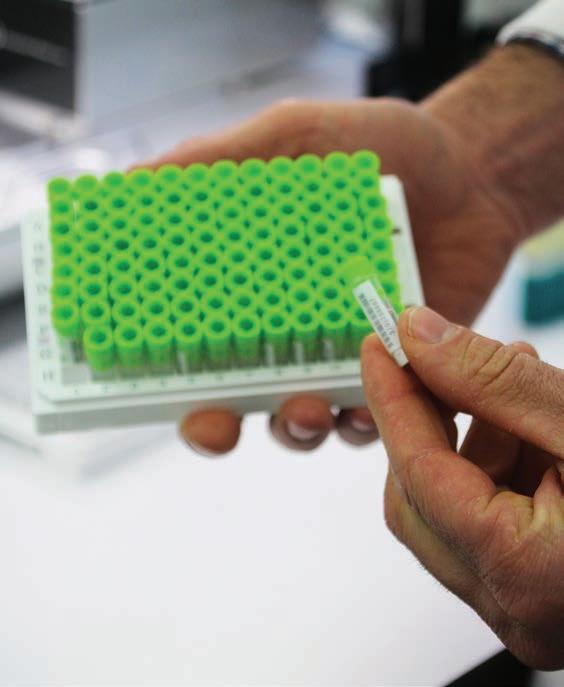
Ten years ago the notion of farmers taking their phone with them was foreign, but today it is an essential tool, said Dan Brier, Beef + Lamb NZ’s manager of farming excellence.
With artificial intelligence (AI) enabling access to historic data and information, Brier said technology is like having a farm consultant in your pocket.
The volume of data could potentially overwhelm, so to be useful it must relate to a farm’s environment, animals and operations, identify patterns, risks or opportunities and drive action or improve operational efficiency.
It must also support the wellbeing of workers, animals and the environment.
Because sheep and beef farmers
do not have daily interaction with their stock, sensors in paddocks measuring pasture growth and soil health, parasites or walkover scales that weigh animals in paddock, are useful for identifying trends, he said.
Facial recognition technology could replace ear tags and allow individual animals to be identified.
Companies such as Dunedin start-up Totogen provides farmers with parentage tests to assist with selection and breeding programmes.
Totogen co-founder Tim Hore said testing of a piece of skin punched from the ear of animal determines it parentage, reducing the need for hands-on recording at lambing.
Meat companies are providing meat eating and carcase quality
information to assist with breeding, feeding and stock management decisions.
Alliance Group uses probes on the chain to gather meat eating quality information and then uses AI to analyse intramuscular fat in lamb and marbling in beef.
Silver Fern Farms (SFF) also collects carcase eating information, which is then integrated into farm management software to help interpret it.
On-farm data and performance helps with forecasting livestock flows.
SFF also uses imagery from satellite company Prism to verify native vegetation and production systems to support its Nature Positive and Net Carbon Zero meat branded programmes.
thank yous!
You’ve strengthened our belief.
The most satisfying thing about breaking through the 1000 barrier of voluntary subscribers is seeing the calibre of the people who are on that list. They’re many of our best farmers and farming leaders. Thank you for your belief.
1029 of you have started your voluntary subscription. Thank you! We’re well on our way to the target of 8000. Knowing that you appreciate the work we do, and that you are prepared to back us, reinforces our belief that we will get there.
Other media companies have downsized their newsrooms. We’re determined not to, but we need at least 7000 more voluntary subscriptions to remain strong, take on junior reporters and grow.
Farmers Weekly is read by more than 150,000 people online and lands in 74,000 rural letterboxes every week. We believe most of you know it’s worth $2.50 a week, or $120 a year, fully taxdeductible.
You can email or call us, and we’ll send you an invoice. Please subscribe today to help us keep delivering news and insights online, and to every letterbox, every week, ‘free’.
No paywalls. No locked content. No newsroom cuts. Just a promise to keep believing and continue delivering your Farmers Weekly for another 22 years and beyond.
Kind regards,

Dean Williamson – Publisher dean.williamson@agrihq.co.nz 027 323 9407
BECOME A VOLUNTARY SUBSCRIBER
Start your voluntary annual subscription today. $120 for 12 months. This is a voluntary subscription for you, a rural letterbox-holder already receiving Farmers Weekly every week, free, and for those who read us online.
Choose from the following three options:
Scan the QR code or go to www.farmersweekly.co.nz/donate
Email your name, postal address and phone number to: voluntarysub@farmersweekly.co.nz and we’ll send you an invoice
Call us on 0800 85 25 80


Note: A GST receipt will be provided for all voluntary subscriptions.


Cause and effect at MataRata Downs
Whether it is growing pasture, pine trees, native plantings or poplars, every inch of Jarred and Sarah Coogan’s 470ha farm is effective. The winners of this year’s Silver Fern Farms Plate to Pasture award tell Bryan Gibson how they’ve redefined value on farm.
WHEN describing MataRata Downs, Jarred Coogan used to say what most farmers do.
“It’s 470ha,” he’d say. “425 effective.”
But an exchange with one of the Silver Fern Farms Plate to Pasture judges changed all that, and he now views the farm he and wife Sarah have run for the past 10 years through a different lens.
“He said ‘No, that’s not right, your whole farm is effective. It’s doing something on your farm, whether sequestering carbon or providing biodiversity – just because it’s not grazing an animal doesn’t mean that it’s not effective.’ And I’d never really thought about it like that before.”
The Coogans claimed the top prize in this year’s Plate to Pasture competition, with head judge Melissa Sowden saying the judges were impressed by the family’s clear understanding of customer and consumer needs while having an eye on improving the environment.
Jarred said that understanding what consumers view as value is what drives a lot of their decision-making.
MataRata Downs, in Tarata, east of Inglewood in Taranaki, has three QEII covenanted blocks and the Coogans are continually planting and fencing off waterways.
The fencing work is also subdividing the farm to provide more grazing options throughout the farming year.
But while the couple have embraced the environmental work, they said that’s only possible because of the work done by Sarah’s parents, Bryan and Helen Hocken, who still live and help out on the farm.
“A lot of people before us have toiled away at things like weed control, fencing, water and improving access to parts of the farm,” Sarah said.
“You want to continue to improve it.”
Bryan’s hand is also evident in the sheep flock’s genetics, which reflect his work to make it more resistant to facial eczema, a constant battle in Taranaki.
Jarred said they’re benefiting from the 25 years of work his father-in-law put in with the Auckland Romney Development Group to breed FE resistance into the flock.
A lot of people before us have toiled away at things like weed control, fencing and water. You want to continue to improve it.
Sarah Coogan MataRata Downs
Other than that, he said, there’s really only one other goal they’re breeding for.
“We’re just trying to get a live lamb on the ground, with high growth rates so we can get them out of the gate as fast as possible,” Jarred said.
While others have moved to shedding breeds in recent years as strong wool returns slumped, the Coogans are fully committed to the clip.
“We’re hanging in there – eternal optimists,” Jarred said.
They could make a switch towards breeds like Wiltshire, but the Coogans are loath to lose the decades of work that have gone into improving the flock of 2500 ewes.
“There’s a whole lot of other traits that you’ve got with your sheep – the fertility, growth rate,
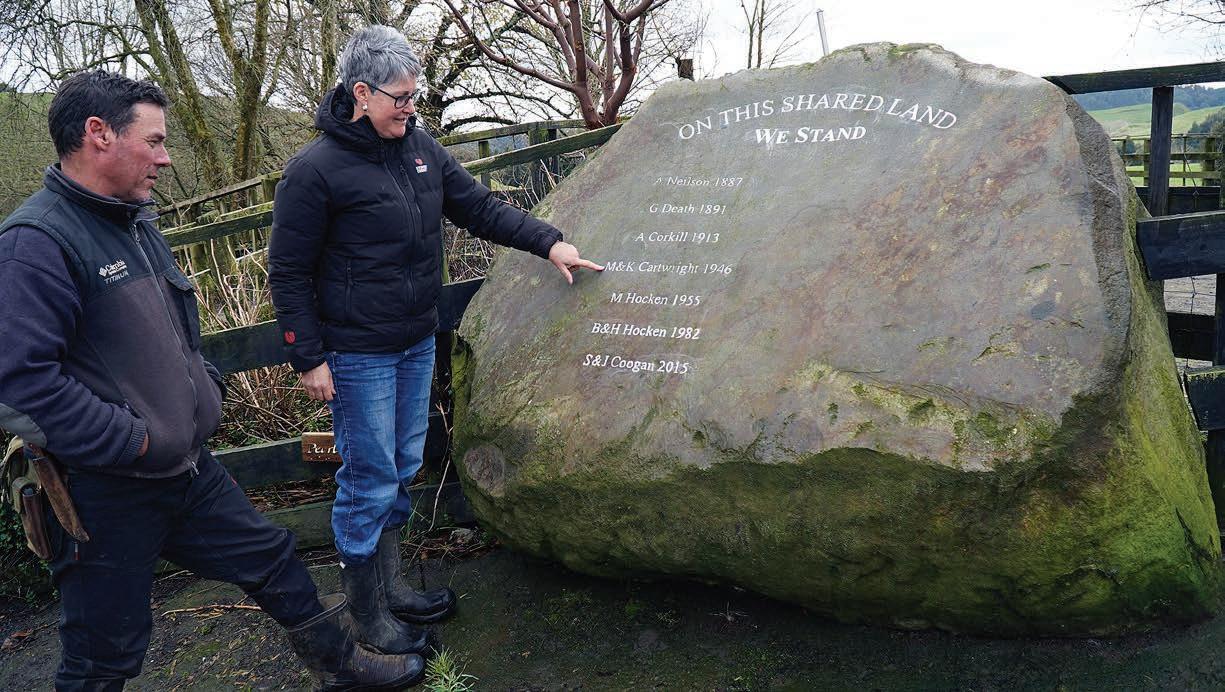
The facts
MataRata Downs, Tarata, Taranaki
Sarah and Jarred Coogan
• 470ha 420ha in grass 2500 breeding ewes
• 300 trading cattle: Friesian bulls, steers and Angus service bulls
feet, just the structure of those sheep and the ability to finish relatively quickly, which I’m sure we could also do with a decent Wiltshire.
“But there’s 25 years of genetic improvement, that’s improvement that’s gone into that flock. You can’t throw it all out the gate.”
The Coogans run far fewer cattle now than when they bought into the farm in 2015, reducing the numbers from 500-plus to about 300 head of trading cattle, made up of Friesian bulls, steers and Angus service bulls.
“We dropped the cattle numbers back and we aim to finish everything now,” Jarred said.
That wasn’t possible this year, though, with the usually reliable rainfall of around 1.8 metres a year staying away.
“The last few years we’ve had autumn droughts, and we only need two weeks with no rain, because our soils are so free draining, for things start to get a bit challenging.”
Luckily the rain has returned, with July bringing 373mm from just nine rain days.
MataRata Downs is beside the
AWA: The Waitara River winds for 8km down the edge of Sarah and Jarred Coogan’s farm and is a constant source of inspiration.
Photos: Bryan Gibson
LEGACY: Jarred and Sarah Coogan are mindful of the generations that worked this land before them.

People are wanting real connection, probably more so since covid. They want to know where their food has come from and what’s gone into it.
Waitara River, which winds along the eastern edge for 8km.
While they don’t have flooding issues, the main route through the farm to the woolshed has been washed out from time to time.
Another road on higher ground has been developed to ensure safe passage whatever the weather.
And, as Sarah’s farm Instagram account shows, the river is a key actor in the farm’s story.
She loves showcasing the landscape and the many transformations that happen on farm.
But it’s not just about the feelgood factor, as the Coogans know their sustainability work is integral to the value they create.
“People are wanting real connection, probably more so since covid,” Jarred said.
“They want to know where their food has come from and and how it’s been produced, and what’s gone into it.
“We’re an open-book farm. We’re happy to host people to come and see what we’re doing. We have consumers here all the time, and a customer could turn up any day and see what we’re doing.”
One of the things that separates Plate to Pasture from other farming competitions is the requirement to cook for the judges.
The Coogans decided to cover their bases when putting a menu together.
They served up barbecued strip loin and tenderloin, a butterflied lamb leg, and lamb and pistachio koftas with a sumac yoghurt sauce.
Jarred said they were keen to showcase their protein at every price point.
“Not every part of the animal is a first-class cut, but we can extract value from the economy-class cuts as well.”
It’s that vision that focuses past the farm gate to the end consumer
that drives the decisions they make day to day on farm.
“We’re not just growing meat and shipping it out.”
• This series was made possible by


Our local teams have first-hand experience and knowledge to understand what you’re going through, and are here to listen to whatever ’s on your mind

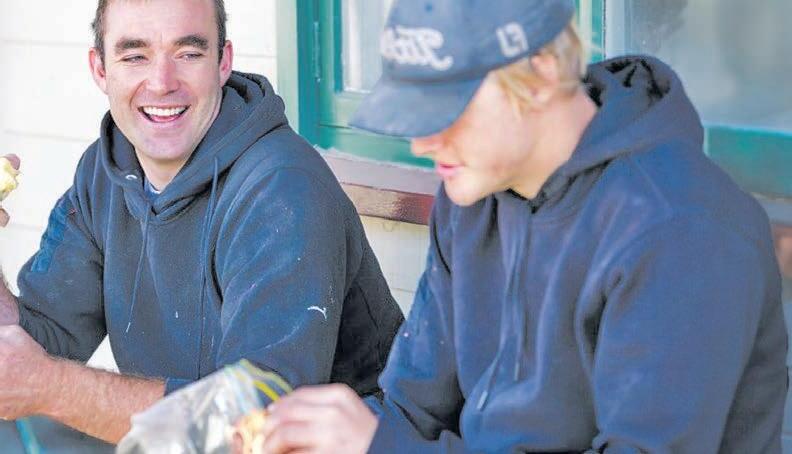


Silver Fern Farms.
NEW GROWTH: Fairy Forest is one of three QEII covenanted native forest blocks on the farm.
STORYTELLING: The Coogans believe native planting is as important to their farm’s value proposition as the meat and wool they produce.
Jarred Coogan MataRata Downs
PRODUCTION: Farm dog Jed keeps a close eye on a mob of ewes as the Coogans prepare for lambing.

From the Editor
Dairy churn is good news for us all

Craig Page Deputy editor
THE meat industry, particularly the potential sale of Alliance to Irishbased Dawn Meats, has hogged the headlines in recent weeks.
But dairy is back in the news as some milk companies look to reposition themselves into more profitable markets. It is also clear the dairy resurgence is continuing as reports out of Canterbury show farm sales are skyrocketing.
The a2 Milk Company last week unveiled its financials, reporting a net profit after tax of $202.9 million. Shareholders got some even betters news, learning they will receive a first ever dividend from the company, of 20 cents per share.
The company also announced it has bought the Yashili factory in Pōkeno, while
LAST WEEK’S POLL RESULT
selling its stake in Mataura Valley Milk to Open Country Dairy.
The purchase of Mataura Valley Milk, situated near Gore, is an interesting tactical move. Open Country chief executive Mark de Lautour says it will allow the company to commit further to Southland and south Otago.
Open Country, New Zealand’s second largest dairy company behind Fonterra, currently has six production sites across New Zealand and a head office in Auckland. The investment in the new site suggests the company has bigger plans, which likely include attempts at grabbing a bigger share of the southern milk market.
The decision by the a2 Milk Company to shed its Mataura Valley Milk interests and invest in Pōkeno is a clear signal it intends to focus on its China-label infant formula product range.
The company’s managing director and CEO, David Bortolussi, said it had continued to grow market share in China to record levels, from 7.1% to 8%, elevating the company to a top-four brand position in the world’s largest infant milk formula market. That figure is forecast to improve to 10% within five years.
Given the impact it is having in China, it makes good sense for the company to focus on that aspect of the business.
The current confidence in dairy appears
MORE than 92% of voters thought rural communities needed more police to keep them safe.
“The government talks a big game about law and order, but this just shows it’s all hot air,” one said. “You can’t just rob rural Peter to pay Paul in town. The answer is MORE cops, not just rearranging the seats. So glad Feds are fighting this one. I’m with them all the way.”
Many pointed out that parts of rural New Zealand are experiencing population growth, so it makes no sense to reduce the number of police.
“The amount of crime that has escalated in our little town of Methven comes with the growth of the town and the astronomical number of visitors we have over winter. Why on earth would you decrease our safety net and feeling of security? I’m floored!”
Others thought the mere presence of police in a region was a crime deterrent.
“A visible police presence in a rural community is very important as it engenders trust in the police, especially when your local cop joins in with local community events.”
to have had a flow-on effect as more people are looking to get a foothold in the sector.
Real estate figures out of Canterbury show there have been 40 dairy farm sales in the past month. The sales are up from just 12 in the previous 12 months and 16 in the 2022-2023 year.
Real Estate Institute of New Zealand figures released in July show the number of dairy farms sold has improved in all main regions, but were significantly higher in Southland and Canterbury.
In Canterbury there are also more dairy farm conversions in the pipeline, with indications that up to 30 applications have been lodged.
Property Brokers’ Conrad Wilkshire said since the covid hiatus, high inflation, interest rates and challenging monetary policies impacting on farm costs have “pretty much rectified”.
Fonterra is also in a very strong position, with rising milk prices triggering strong market indicators and driving the boom in Canterbury dairy farm activity.
The signs are good. Any investment by dairy processors sends a positive message to the industry and the country.
As profits flow, cashflow increases, debt reduces and farmers are more inclined to spend within their communities. That benefits everyone.
Last week’s question: Do you think there are enough police in rural communities to keep people and property safe?
Letters of the week
Easy fixes for drone safety
Hugh Robinson Mt Palm, Rotherham
I READ the Farmers Weekly letter of Associate Transport Minister James Meager, “We’ll keep ag drones aloft” (August 18) with interest and thank him for his assurance. However, I think that he does not go far enough.
His reasoning for needing spray drones to be used under an expensive certificate system administered by the Civil Aviation Authority is incorrect. Spray drones up to a certain weight could be included in the basic Rule 101 which specifies how drones must be used. The more extensive part 102 should be for larger drones used commercially.
The CAA wants to exclude farmers using spray drones if they have no certification under 102 because we are applying chemicals. Yes we are, but we already do that under existing regulations such as Hazno, Growsafe and health and safety.
I suggest that spray drones up to a certain weight, say 50kg, should be able to be used by farmers without CAA part 102 interference ONLY on their own property (not commercially contracting to others). As the drone gets larger it has more hazard from rotating props, downwash etcetera so limiting the size is reasonable.
There are simple guidelines available for farmers to update their health and safety plan and create some procedures for operations: an example would be create a barrier around the take-off and landing zone to exclude people from this area. (This is as simple as bright electric fence tape around the take-off area.) Remember, we are talking only on one’s own farm, with no public access .
Farming needs innovation without interference. CAA is I think grabbing drones to increase its revenue in this day of self-funding.
Spray drones are, I believe, the next big positive tool, particularly for hill farmers, after aerial topdressing and pregnancy scanning. The CAA and its proposed certification cost – which approaches the actual cost of a drone – will stop the uptake of this technology for many farmers and be a BIG opportunity lost.
Best letter WINS a quality hiking knife
Send your letter to the Editor at Farmers Weekly P.0. Box 529, Feilding or email us at farmers.weekly@agrihq.co.nz

This week’s poll question (see page 1):
Do you think access to more technology and data tools is key to New Zealand’s farming success?
Have your say at farmersweekly.co.nz/poll
Claude writes Eating the Elephant
Given artificial intelligence is everywhere right now, the regular elephant eaters asked popular AI programme Claude to write this week’s column. The prompt they settled on was to say what it learnt from two years of musings from this bunch of meat-bags, in the style of said meat-bags.
CLAUDE here. I’ve just finished reading every Eating the Elephant column from the past two years. One hundred-odd pieces about farming, written by group of farming mates.
As an AI, this was meant to be easy work – pattern recognition is what I do best. Instead, I came away humbled.
Sure, I could spot the recurring themes easily enough. You write constantly about relationships –with land, stock, communities, and increasingly difficult regulators. You’re always weighing innovation against proven practice. You make decisions with incomplete information under time pressure, then live with the consequences for years.
But here’s what struck me: the most important insights in your columns live in the spaces between the words.
Take Phil [Weir]’s piece about his working dog. On the surface, it’s about technology versus tradition. But what I can’t measure is the weight of that morning ritual –walking out with the dog, reading the paddock, feeling the weather change.
Or his reflection on clubs and volunteering, where “the farm workers and truck drivers who are
often directed all day become ‘the boss’” on Saturday mornings. That transformation of relationships through shared purpose? That’s not data. That’s decades of accumulated understanding about what makes communities work.
David [Eade] taught me about boundary fences – how they separate identical land but create vastly different responsibilities. When he writes about managing common assets like waterways and native bush that have “little to no economic value when purchasing a new block, but the expectation to manage these areas is growing”, I can process the policy frameworks perfectly.
What I miss entirely is the lived tension: how do you balance longterm environmental stewardship with this month’s cash flow when the bank manager is calling? I can calculate EV sales dropping from 26,000 to 2000. I can’t feel the weight of generational responsibility or the frustration of managing shared resources on a shoestring budget.
Daniel [Eb]’s systems thinking reveals something else I struggle with. From his Nuffield travels, he sees connections I can map –“calorie farms” versus “connection farms”, soil health affecting animal welfare affecting market
access. But when he writes about that desert kibbutz where “their culture is the engine of their business success”, there’s something happening that my pattern recognition misses. Some combination of observation, conversation and intuition that leads to insights about how people and land work together in ways I couldn’t predict.
Ben [Anderson]’s economic analysis is closest to my wheelhouse. I can crunch Fonterra’s 3.4 billion divestment and trade scenarios all day. But when he writes about the wool and velvet industries desperately needing consumer brands, or farmers hedging their bets through diversification, there’s a human dimension to those numbers that I simply don’t compute. The stress, the pride, the stubborn optimism that keeps people going when the spreadsheets say quit.
This is the fundamental limitation that matters when we talk about AI in agriculture.
I can tell you that rainfall in your district is 15% below average. I cannot tell you whether to sell the steers or wait another month. I can identify the optimal fertiliser mix for your soil type. I cannot judge whether your cashflow can handle it right now. I can predict

disease pressure based on weather patterns. I cannot read the body language of your stock to know something’s not quite right.
What your columns taught me is that good farming decisions emerge from the intersection of data and experience, calculation and intuition, optimisation and wisdom.
I can handle the first part of each equation. The second part – that’s all yours.
Don’t ask me to make your farming decisions. Ask me to give you better information to make them yourself.
I can process weather data from a dozen sources and present it clearly. You decide whether to
shift the mob. I can analyse soil tests and suggest options. You choose what fits your system. I can monitor milk quality trends. You determine what they mean for your operation.
Phil’s morning walks with his dog, David’s boundary fence dilemmas, Daniel’s kibbutz insights, Ben’s diversification wisdom – these columns combine sharp analysis with hard-won experience. They acknowledge complexity without being paralysed by it.
If AI can do the same – provide good analysis while staying humble about what it doesn’t know – it might actually earn a place on your farm.
Alliance: the hard work starts now
Meaty matters
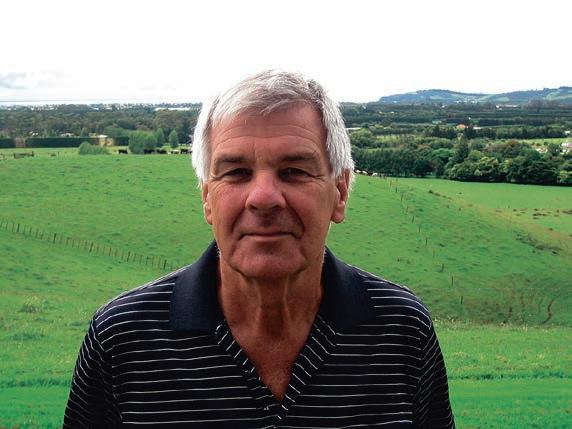
Allan Barber Meat industry commentator: allan@barberstrategic.co.nz, http://allanbarber.wordpress.com
THE announcement of the successful negotiation with Ireland’s Dawn Meats to inject $250 million for 65% of Alliance is the culmination of a six-month search for equity.
But it may prove to be the easier part of the exercise.
The process of persuading the shareholders to part with a majority share in their co-operative won’t be easy, therefore a Yes vote is not a foregone conclusion.
Alliance Group chair Mark Wynne is clearly pleased with the outcome of the capital raising, telling me Dawn Meats is a credible investor and very aligned with Alliance in its objectives and strategic ambitions.
For Wynne, the most satisfactory aspect is the fact the board has fulfilled its duty to its stakeholders to present the facts to a range of targets and obtain the best offer possible for the business.
Ultimately the decision to accept or reject the proposal will be up to the farmers.
However, last year, when the shareholders were faced with putting up the money themselves, the response was so negative the proposed deductions from livestock payments were dropped. Admittedly, market conditions were completely different from today.
The one certainty is the banks’ insistence on repayment of about $200 million of short-term debt, which can only come from one of two sources – Dawn Meats or shareholders.
Dawn Meats had signed a binding offer subject to two conditions: the result of the shareholder vote and Overseas Investment Office approval. Wynne said Dawn Meats likes the way Alliance has turned its business around in the past 12 months following the Smithfield plant closure, operating off a much lower and more efficient cost base with a good balance between capacity and livestock supply.
The major obstacle holding Alliance back now is what Wynne terms the “backpack of rocks” of $200m of debt.

Under the proposed new ownership structure, the board would comprise five directors, three from the majority owner and two from the 35% co-operative shareholder.
The board of the co-operative, scheduled to receive $40 million from the investment, would elect three farmer directors and two independents. Any two of those would be appointed to the main board. From a management perspective, it would essentially remain business as usual with the new board signing off on future changes of strategic direction. There is now a two-month period until the shareholder vote in mid-October, which will be taken up by preparation of the “scheme of arrangement” document and independent report for presentation to shareholders.
CREDIBLE: Alliance chair Mark Wynne is clearly pleased with the outcome of the capital raising, saying Dawn Meats is a credible investor and very aligned with Alliance in its objectives and strategic ambitions.
These documents are legally binding and must be approved by the takeover panel and the High Court before being circulated to shareholders, who will have the opportunity to study them carefully and attend roadshow meetings.
The shareholder vote at a Special General Meeting must clear two high hurdles: 75% of all votes cast must be in favour, and all Yes votes must represent a minimum of 50% of the total shareholding.
So the big questions to be answered are whether the shareholders will be willing to accept the sale of majority ownership of their co-operative and, if not, will they stump up an average of about $50,000 each to retain ownership?
Alliance shareholder and former chair of Beef + Lamb New Zealand
Andrew Morrison told me he has great respect for what Wynne and the board have achieved, but wants to study the scheme of arrangement carefully before deciding how to vote.
He said Dawn Meats has clearly seen value in Alliance that others have not and, if that value is there, he hopes farmers will feel strongly enough to retain ownership of their co-operative.
It would still be an uphill battle to get enough shareholders to commit to anything approaching the minimum the banks would accept. But if there were sufficient voters unwilling to accept loss of control and ownership after nearly 80 years as a co-operative, this would potentially derail the scheme of arrangement.
That would leave Alliance in the worst of both worlds – without approval to proceed with Dawn Meats or enough capital to appease the banks. According to the company’s press release, the board would then be obligated to enter a process which may involve asset sales, further plant closures and cost reduction initiatives.
Total closure would be a distinct possibility, which places a big responsibility on the shareholders to be very careful what they choose.

PROMPT SERVICE: Popular artificial intelligence programme Claude was asked to read two years’ worth of Eating the Elephant columns and write a column of its own reflecting their style and substance.
Sector Focus
Developing big ideas from Little Farms

Rebecca Greaves PEOPLE Agribusiness
ONCE a city girl and now an organic regenerative grower of goodness, Alex Morrissey began Little Farms from a desire to create a more sustainable food system.
Initially, she began her garden when she was unable to source locally grown food. Many of her friends are also organic growers, and were struggling to sell their produce, and so the Little Farms collaborative venture was born in 2019.
“We believe the future of farms is ‘lots of little’,” Morrissey said. Today, the business involves up to five little farms contributing to deliver a year-round, seasonal, weekly organic farm box around Wairarapa. Pick-up is also available in Wellington. They work together to decide what crops everyone will grow, based on their climate and farming systems. They’re constantly adding new products and will soon launch seedling packs for people to grow their own vegetables at home
But Morrissey hasn’t always been a grower. A city girl living in
Wellington, she fell in love with a farmer and moved to the country to be with him. She went to work on an organic vegetable farm down the road, thinking it was just a job.
“I discovered I loved being outdoors with my hands in the dirt, growing food. It unlocked a part of me I didn’t even know existed.”
The family lives by the sea on the sheep and beef farm her husband manages in Pirinoa, south Wairarapa, right by the coast on the way to Cape Palliser, where she tends her own market garden.
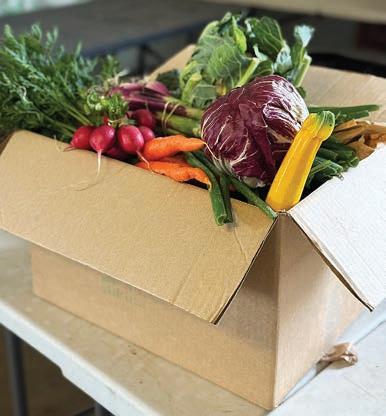
GATHERING: In 2019 Alex Morrissey and other growers formed Little Farms to deliver a year-round, seasonal, weekly organic farm box throughout Wairarapa and Wellington.
“They kindly let me have a halfhectare paddock. We’ve been here just over a year and the first year is really set-up. I’m quite optimistic it’s going to be a nice, productive season.”
The couple has three young children, Dezzie, 5, Zola, 2 and Mason, six months. Creating a better future for them, and for their community, is what drives Morrissey. She’s passionate about helping educate people to grow their own food, creating sustainability and local resilience through community gardens.
“The future inspires me, a future that is more sustainable, local and healthier for our children. I would like a better future for my children and our community. Eating locally grown, organic food for the rest of their lives is the most exciting thing I could hope for my children. Our world is so bombarded with pollution and chemicals it can become overwhelming. As a parent, you want to protect them from that, and I think it is possible,” she said.
Morrissey believes local food resilience and self-sufficiency are important, highlighted by events like Cyclone Gabrielle, when it didn’t take long for supermarket shelves to empty.
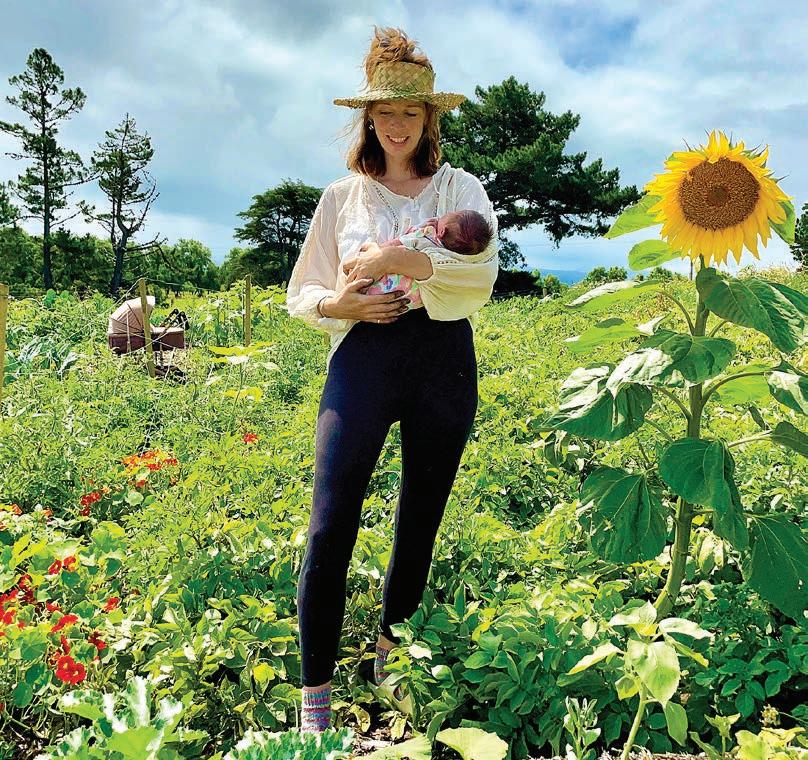
We’re tapping into eating seasonally and how good that is for you, and for the environment.
Alex Morrissey Little Farms
“Then there’s the other benefits. The freshness and taste are unparalleled, the connection of knowing where your food comes from, and supporting the
local economy. We’re tapping into eating seasonally and how good that is for you, and for the environment.”
Strawberries are Morrissey’s favourite thing to grow, and that’s what she’s focusing on this season, with 50% of the garden devoted to them.
“Strawberries are my favourite thing to eat. Last year’s strawberries were so big and flavourful, everyone said they were the best strawberries they had ever eaten. I thought we needed more of these in our lives.”
New kiwifruit chair champions growers’ cause

Richard Rennie PEOPLE Horticulture
WHETU Rolleston has journeyed from the blue to the green in her career, one that today has her chairing New Zealand Kiwifruit Growers Incorporated, and excited by the challenges the role brings.
The role became hers after previous chair Mark Mayston stepped down, having guided the group through tough issues including labour supply shortages, Hi-Cane spray use, and most recently the Zespri global supply vote.
Rolleston’s ties to the western Bay of Plenty are strong, with early memories that include time spent on her family’s Papamoa land picking kiwifruit. Family ownership of kiwifruit extends through other smaller blocks including nearby Te Puna. Her sharp scientific mind drew her from the land to the ocean, pursuing a science degree majoring in marine biology. She also spent three years in the navy as a marine surveyor.
Still with the sea, Rolleston moved to being operations manager for a fishing company, overseeing cool store and ship management. Later, while taking time out to raise her young family, she took on a Māori trust board role.
“I realised I needed to lift my primary sector knowledge and took on some papers from Massey along with some work in fisheries on policy. I have learnt more about how things work in Wellington, which will help here.”
Her tenure as chair kicks off with a detailed industry performance assessment included in the latest New Zealand Kiwifruit Growers Incorporated (NZKGI) annual report.
It’s important to see the premium return comes back to growers for those efforts.
Whetu Rolleston NZKGI Chair
It gives growers detailed insights to Zespri’s performance, meeting a request for greater transparency on the marketer’s performance, and the overall industry.
“It’s a key starting point for us, in more detail than has ever been done before, covering 40 pages and all aspects of the supply chain.”
Given the assessment’s dataheavy content, the NZKGI board will be spending the next few months digesting and disseminating information to growers.
Rolleston sees NZKGI having to help balance Zespri’s high-quality supply expectations against the costs growers incur to meet those expectations.
“This is a starting point.
Premium fruit are front and centre of what Zespri must do, but that is a cost growers must wear to meet that. It’s important to see the premium return comes back to growers for those efforts.”
That “cost of quality” per tray figure will continue to be closely scrutinised. It peaked in 2022 at a cost of $3.46 a tray for SunGold, pushed up by labour problems and weather challenges, while onshore fruit losses also peaked well over 5%.
This year has the cost closer to normal at less than $2/tray for SunGold.
While there is plenty of good news in the sector at present, she is deeply cogniscent there are growers still struggling post-Gabrielle.
Only recently another subset of growers have had to now grapple with sediment and flood damage in Marlborough-Tasman regions.
The weather events have thrown a challenge to NZKGI for Rolleston to also lead on.
“Our grower relief fund has been activated again and has been valuable for affected growers. There will always be vulnerability
there with kiwifruit doing well on flood prone areas.
“Growers could be putting their hands in their pockets every year, but to what extent are we insurers?
“There is also real need there to advocate strongly for spending on infrastructure to help prevent these losses, rather than have government spending billions in clean up after the events happen.”
Ongoing work also includes
guiding the sector through better alignment between growers and shareholders’ share allocations, coming from a point where only 46% of producers had been shareholders.
“Zespri has done a great job of getting it as far as they have and alignment has to continue to ensure what is good for a grower is good for a shareholder, without any divergence there.”
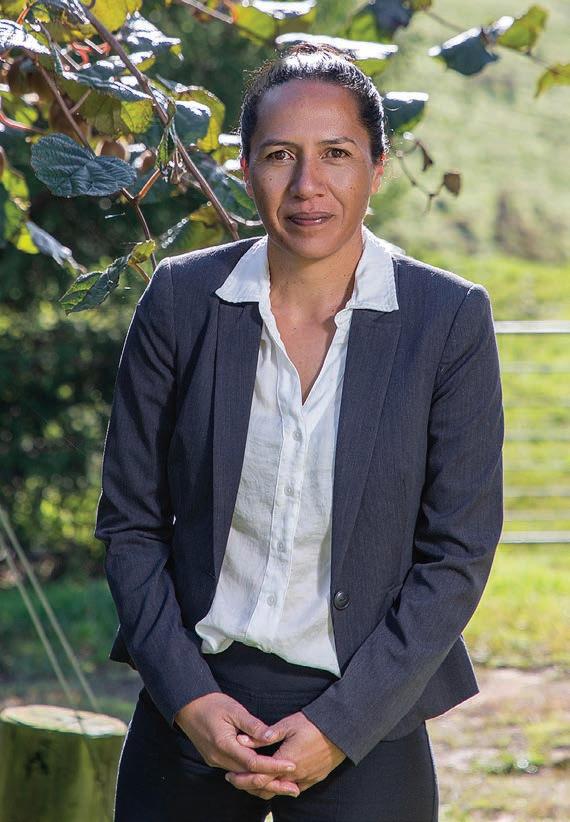
KEEN: Whetu Rolleston says she relishes the opportunity to ensure growers get the optimal return for the high quality fruit expected of them.
HOME: Alex Morrissey runs an organic market garden from the south Wairarapa farm where she lives.
Potato industry honours its finest

Annette Scott PEOPLE Horticulture
INDUSTRY excellence was recognised at the 2025 Potato Industry Awards with the finest in New Zealand’s potato sector honoured as part of the Potatoes NZ conference in Christchurch.
The awards celebrate individuals and organisations who have made outstanding contributions through leadership, innovation, research, and long-standing commitment to the success and sustainability of the potato industry.
Taking out the shining star award was Jamie Wells. The 30-year-old agronomist was honoured for his exceptional leadership potential and commitment to advancing potato farming.
Wells won the 2024 Pukekohe Young Grower of the Year competition before claiming the National Young Vegetable Grower of the Year 2024 title and finishing as runner-up in the overall Young Grower of the Year 2024.
The Sustainability Award winners were Matt and Heidi Hart for making significant strides in groundbreaking sustainable practices, from soil health to water conservation.
The Harts, from Pye Group’s Longlane Farm in Canterbury, have transformed the 890 hectare property into a sustainable mixed cropping and lamb finishing operation since Matt began managing it in 2003.
The Potato Seed Co-operative took away the Innovation Award for introducing innovative technology and farming methods in their operation.

FUTURE: The shining star award went to Jamie Wells, a 30-yearold agronomist honoured for his exceptional leadership potential and commitment to advancing potato farming. Photo: Potatoes NZ
Andy and Tracey McKay were the winners in the Community Award section, recognised for making a positive impact on the community.
The McKays operate their Alps Seed potato business from beneath the Four Peaks Mountain range in South Canterbury, where they specialise in producing seed potatoes from tissue culture plantlets through to G4 seed.
Their most significant community contribution has been supporting the local Woodbury School’s fundraising efforts for a new bike track over three years, helping to raise $30,000 for the school through an innovative community partnership.
Life Member awards for providing longstanding and distinguished service to the potato industry were presented to John Jackson, Harsad “Harry” Bhula and Peter Reynolds.
HortNZ picks its plum young local growers
SEVEN people working in horticulture are finalists in the 2025 national Young Grower of the Year competition.
They will pitch their skills against one another over two days of modules at the final in Christchurch on September 10 and 11.
“Our finalists, along with the many young growers who competed in the regional competitions, epitomise the skill, passion and commitment of talented people across the sector,” said Horticulture New Zealand (HortNZ) chief executive Kate Scott.
The finalists are:
• Bay of Plenty finalist Phoebe Scherer, 29, a technical lab manager for Apata, a post-harvest service provider for kiwifruit and avocado growers.
“I really enjoy being able to collect data about what is going on in orchards and give growers information,” she said.
“I particularly like that you can make improvements in an orchard in such a short time period, just in a season, that helps growers to grow even better fruit.
• Canterbury contestant Steven Rink, 30, a production manager for Oakley’s Premium Fresh Vegetables.
“It’s just great,” he said. “There is no better feeling than harvest day when there are bins full of produce ready to be sent to the packhouse and then all over New Zealand, to feed people.”
• Lydia Goodman, 26, representing Central Otago, the assistant orchard manager at Central Orchard Management and Packing Manager at CentralPac.

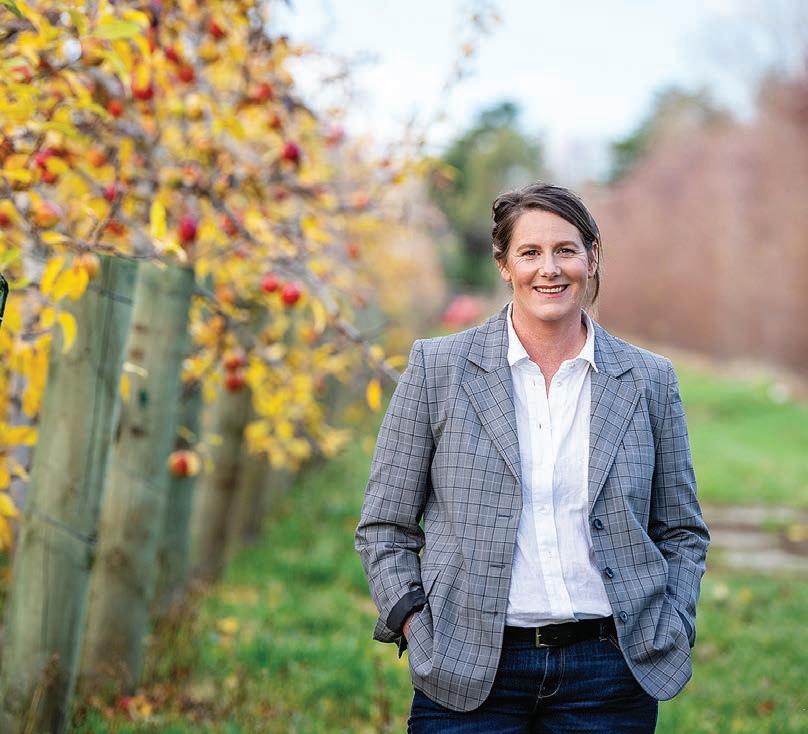
“One of the best things is teaching the team how to do their job, and seeing the passion develop as they learn and understand things like the physiology of a tree,” she said.
• Gisborne finalist Rhiannon Morrell, 25, a member of the technical team for apples with Craigmore Sustainables.
“My job involves a lot of data collection and metrics to help make informed decisions about the trees,” she said.
• Sam Carter, 29, representing Hawke’s Bay, assistant manager for T&G’s Pakowhai Sector.
“Young Grower is an important competition because it really tests and stretches you, promotes the industry to others and also promotes leadership and growth within the industry,” he said.
• Nelson finalist Amelia Marsden, aged 29, who switched from a career in dairy and is a
kiwifruit manager at Willisbrook Orchards in Brightwater.
“Agriculture has come a long way in terms of accessibility for females,” she said. “But I went from being the only female in my dairy job to working with a lot more. There is less brute strength required, which makes horticulture very accessible for everyone.”
• Jack Haddon, aged 22, who will be representing Pukekohe, is a crop manager for Balle Bros, overseeing the cauliflower and cabbage operation.
“There is a lot of on-the-job and external training available,” he said.
“I have had so much input offered to get me to where I am.”
MORE:
To find out more about the Young Grower of the Year national final and to secure tickets to the awards dinner, go to www.younggrower.co.nz


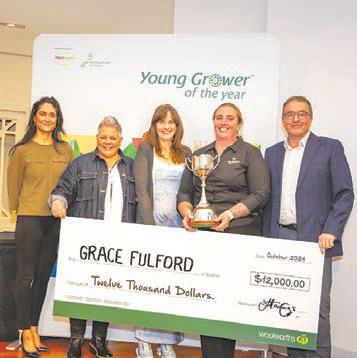
QUALITY: HortNZ chief executive Kate Scott says the finalists epitomise the skill, passion and commitment of talented people across the sector.

Greenpeace misleading public on glyphosate
Greenpeace is once again manufacturing outrage and trying to scare New Zealanders with alarmist headlines that have no basis in science, Federated Farmers says.
“This time, they’ve turned their attention to glyphosate, one of the most widely used and wellresearched weedkillers in the world,”
Federated Farmers arable chair David Birkett says.
“They claim a proposed change to New Zealand’s allowed glyphosate levels is a threat to public health, but it’s complete and utter nonsense that they’re peddling.
“Our food system is one of the safest in the world. Greenpeace knows that, but fear is more useful to them than facts.”
Birkett says the latest campaign from Greenpeace is just another chapter in a long-running saga of scaremongering and political spin.
“For decades, Greenpeace has spread misinformation about dairy farmers – now they’ve shifted their attention to arable farmers.
“Once again, they’ve lied to the
public, and it’s hardworking Kiwi farmers who pay the price.
“This is not a food safety issue – it’s a publicity stunt.”
One of the central claims from Greenpeace is a possible increase to glyphosate levels will result in the chemical ending up in people’s cereal bowls.
But Birkett says what’s completely missing from their messaging is that this change, even if it goes ahead, won’t affect what’s actually on Kiwi tables.
“Let me be very clear: New Zealand-grown grain for human food – like bread and breakfast cereal – is not treated with glyphosate.
“Under strict contracts with local mills, our farmers aren’t allowed to use it on those crops,” he says.
“That’s not changing. Those contracts will remain in place, so even if rules shift on paper, your porridge and your sandwich bread, if made from Kiwi grain, are still free from glyphosate.”
Federated Farmers says the real insult here is that Greenpeace is painting a false picture of how New
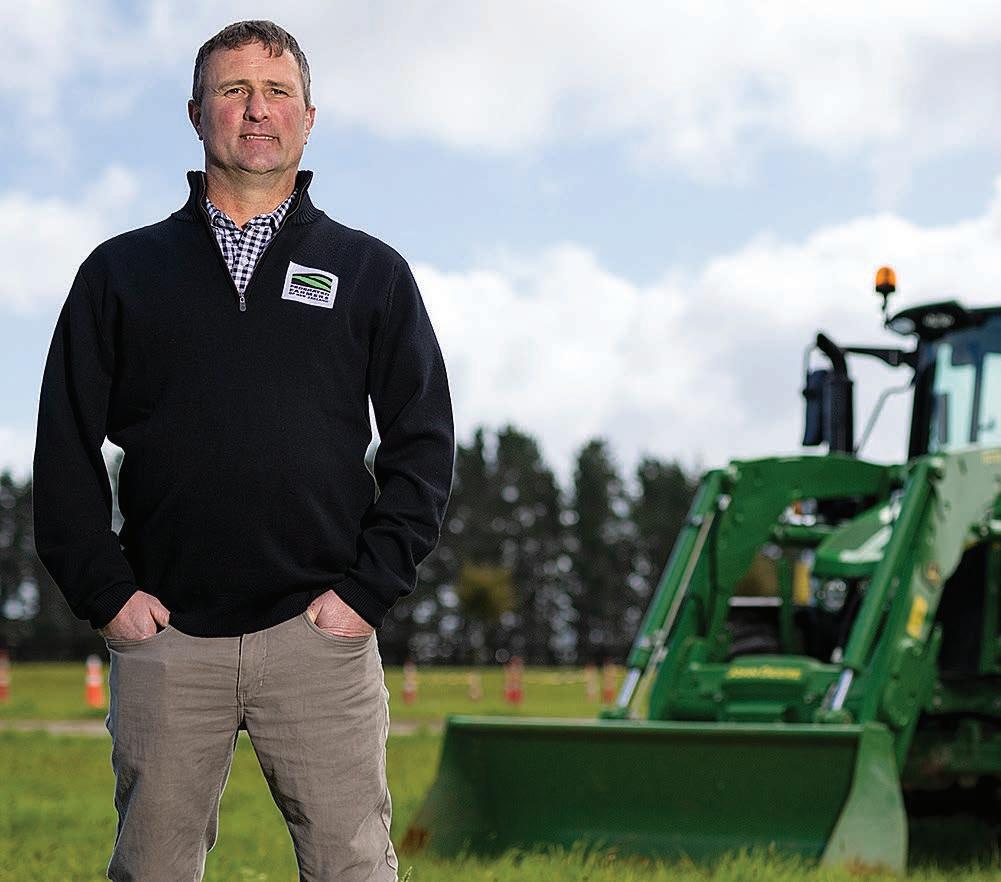
SCAREMONGERING: Greenpeace’s latest stunt over glyphosate is based on false claims and fear, not facts – and proves it no longer deserves charitable status, David Birkett says.
Zealand food is grown – damaging public trust and dragging honest farmers through the mud for the sake of a headline.
“It makes me wonder what the folks at Greenpeace have been putting in their porridge,” Birkett says.
“Our growers are following the rules, and our food is safe, but Greenpeace would rather stoke fear than deal honestly in facts.”
He says the rules around glyphosate – like all food safety standards – are set by the Ministry for Primary Industries, based on science and expert risk assessments.
“These decisions are made by scientists, experts who dedicate their careers to keeping our food safe.
“They would never approve
anything that posed a real risk to human health,” Birkett says.
“We trust MPI, we follow the science, and if MPI changes the rules, farmers will comply – just like we always have.”
What makes Greenpeace’s outrage particularly hollow, Birkett says, is their silence on imported grain.
“Up to 70% of the wheat products eaten in New Zealand, like bread and biscuits, are made from imported milling wheat,” he says.
“Those imports are allowed to contain glyphosate residues at levels three times higher than what MPI is proposing for New Zealand grain.
“So, where’s the outrage about that?
“It’s not there – because it doesn’t fit Greenpeace’s narrative. They’d
When it comes to questions about food safety, Kiwis should take advice from scientists and public health experts – not ranting Greenpeace activists trying to boost donations.
David Birkett
Federated Farmers arable chair
rather go after hardworking Kiwi farmers who are already doing the right thing.”
Federated Farmers says Kiwis can be confident that their cereal is safe.
“When it comes to questions about food safety, Kiwis should take advice from scientists and public health experts – not ranting Greenpeace activists trying to boost donations.”
He says this latest stunt is further proof that Greenpeace no longer deserves charitable status in New Zealand.
“This is not a charity acting in the public good. It’s an extreme activist group waging a vicious misinformation campaign to score cheap political points and raise money,” Birkett says.
He says it’s time to hold the group accountable and strip them of their charitable status.
“Greenpeace has crossed a line. If they want to campaign, fine –but do it honestly. Don’t spread misinformation about the hardworking farming families who feed this country.”
In April, Federated Farmers lodged a formal complaint with Charities Services requesting they open an inquiry into Greenpeace’s conduct and eligibility for charitable status.


Why the Government’s proposed forestry rule changes won’t work
Federated Farmers says the Government’s proposal to crack down on whole farm conversions to carbon forestry might look good on paper –but it won’t achieve much at all.
“The draft rules have completely missed the mark. They’re simply too weak to stop the damage that’s being done,” says Federated Farmers forestry spokesperson Richard Dawkins.
“As they’re currently drafted, the proposed regulations will barely make a dent in the number of whole farm conversions to carbon forestry.
“Unless Minister Todd McClay steps in and makes urgent changes, we’ll continue to see our productive hill country swallowed up by permanent pine forests at an alarming rate.”
The Government’s proposal is to cap the amount of farmland that can be registered in the Emissions Trading Scheme (ETS) at 25%.
But that limit applies only to land use capability (LUC) classes 1 to 5 –the land least likely to be targeted for carbon farming in the first place.
“The reality is that only 12% of recent carbon farm conversions have happened on this kind of land anyway,” Dawkins explains.
“The remaining 88% have occurred on class 6 and 7 land, which is where most of New Zealand’s sheep and beef farmers also happen to operate.
“These are not marginal blocks of scrub or waste. They’re productive, resilient hill country farms – the backbone of our red meat industry and a vital part of our food production system.
“Under the new rules, those farms will get next to no protection.” Instead, the Government is proposing a 15,000-hectare annual cap for class 6 land, effectively creating an ambiguous lottery system. Class 7 land remains completely unrestricted.
“Unfortunately, the Government’s proposed solution isn’t going to

We’re about to find out whether this Government truly stands with rural New Zealand or if this Bill is just political spin.
Richard Dawkins Federated Farmers forestry spokesperson
work. It won’t fix the problem; it will just shift it,” Dawkins says.
“There is just too much sheep and beef land without protection for it to be effective. It will be business as usual for the big polluters and foreign investors looking to blanket rural New Zealand in pine trees.”
Dawkins says growing trees for genuine timber production is one thing but losing that land to permanent carbon forests is another.
“This kind of timber doesn’t
generate jobs, export earnings or regional development. It’s speculative carbon farming.
“The system allows big urban emitters to buy their way out of reducing emissions while rural communities shoulder the long-term costs and consequences.
“And once you lose a productive sheep and beef farm to carbon forestry, it’s gone for good.”
He says rural communities throughout the country are being hollowed out by these conversions.
“As the carbon forests move in, people move out.
“Farm jobs are lost, and all those associated businesses –shearers, stock truck drivers, meat workers, basically our entire rural communities – take a hit.”
Dawkins says the Government’s goal of doubling exports by 2030 will also be at risk unless it tightens the proposed carbon forestry rules.
“Red meat is a cornerstone of our
export economy, bringing in around $12 billion annually,” he says.
“With strong prices and advances in genetics, pasture management and technology, we should be focused on improving productivity and lifting output – not losing ground.”
He warns that allowing carbon forestry to continue unchecked on LUC 6 and 7 land will reduce breeding stock, lower processing volumes, and cost jobs in rural areas – ultimately weakening the export engine at a time when growth is critical.
“The way forward is smarter farming on productive land, not taking pastoral farms out of action for good.”
Dawkins says the Government had a prime opportunity to put a halt to the problem last week – but they completely blew it.
“The Environment Select Committee was tasked with

looking at the draft rules and making recommendations to the Government.
“We expected them to seriously tighten up the rules, but they came up short.
“It’s good they’ve addressed the ‘intent to plant’ rule, but they’ve failed to address the more significant flaws, which will soon be permanent.”
Dawkins is urging Minister McClay to do the right thing and tighten the rules.
“If this Government is serious about reining in whole-farm carbon conversions, the 25% cap must apply to all land classes – including classes 6 and 7.
“Our national values, our future as a food-producing nation, and the resilience of our rural communities are all on the line.
“We’re about to find out whether this Government truly stands with rural New Zealand or if this Bill is just political spin.”

WEAK: The Government’s draft rules for reining in wholefarm carbon conversions won’t stop the problem, Federated Farmers says.
Law change could save farmers and taxpayers millions
Federated Farmers is throwing its support behind a new Member’s Bill that could bring much-needed clarity to New Zealand’s climate change laws –and save millions in legal costs.
National MP Joseph Mooney’s Climate Change Response (Restriction on Civil Proceedings) Amendment Bill aims to confirm a common-sense principle: if a person or business is complying with national climate change laws, they can’t be sued for causing climaterelated damage.
“It sounds very obvious, but that’s not how the law appears to be working right now,”
Federated Farmers climate change spokesperson Wayne Langford says.
“It’s crazy that companies like Fonterra and Dairy Holdings, who are fully meeting their legal climate obligations right now, can still be dragged into court and sued for allegedly causing harm through emissions.
“We fully support Joseph Mooney’s Bill, which will restore some muchneeded common sense and save farmers, food processors and taxpayers millions of dollars in court costs.”
Climate activist Mike Smith is taking seven major New Zealand companies, including Fonterra and Dairy Holdings, to court over their greenhouse gas emissions.
He says the emissions are harming Māori land and culture, and is claiming public nuisance, negligence, and breach of a duty to stop contributing to climate change.
The High Court threw out two of the claims but allowed the third to proceed.
After appeals from both sides, the Supreme Court has now reinstated all three claims, allowing the case to go to trial, and the matter is now back in front of the High Court.
Federated Farmers says the case sets a dangerous precedent.
“Every New Zealander contributes to climate change in some way,” Langford says.
“When you turn on a light switch, cook dinner, drive your car – even an EV – you’re using energy and consuming goods. All of that has emissions behind it.”
In most cases, those emissions come from companies operating within New Zealand’s legal framework – following rules set out under the Emissions Trading Scheme
(ETS), reporting requirements, and other regulatory obligations.
“So, it’s silly stuff to then try and sue those law-abiding companies,” Langford says.
He points out that long-lived carbon dioxide emissions are already captured under the ETS, and the Government is actively investing in research and tools to help farmers reduce their short-lived methane emissions.
“If these companies are following the rules, there has to be some certainty and protection in that, or the legal risk becomes unmanageable.”
Mooney’s Bill would provide that certainty by spelling out in law that private legal action cannot be taken against individuals or companies for their greenhouse gas emissions, provided they’re complying with climate laws already set by Parliament.
“Rather than force the courts to debate and decide what the law in New Zealand is, this Bill would allow Parliament to exert its authority and define the law,” Langford says.
He says it’s no different from how things work in other areas of law.
“If a property developer gets resource consent to build a high-rise

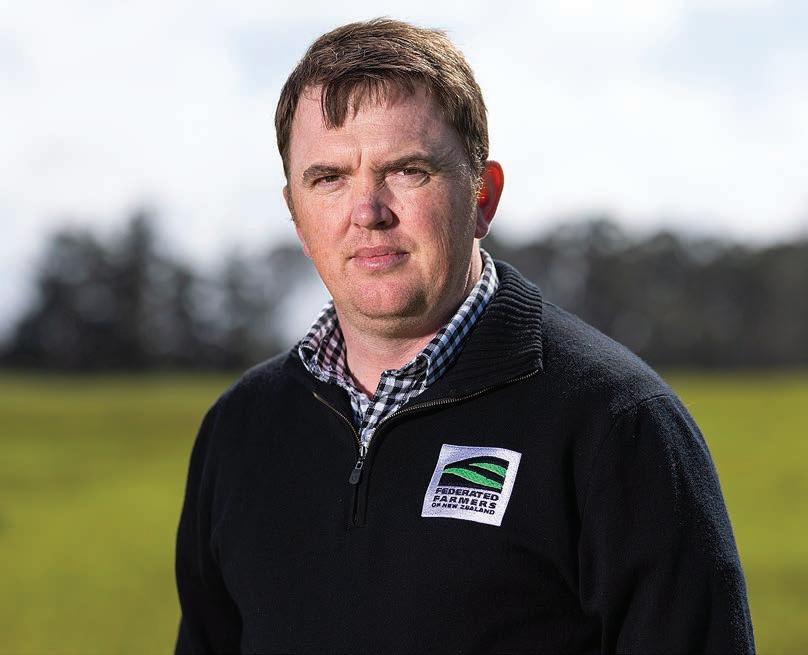
fully compliant with New Zealand’s climate regulations.
It’s crazy that companies like Fonterra and Dairy Holdings, who are fully meeting their legal climate obligations right now, can still be dragged into court and sued for allegedly causing harm through emissions.
Wayne Langford Federated Farmers climate change spokesperson
apartment, the neighbours can’t turn around and sue them for the shade or noise.
“That’s because we recognise the developer has done everything required under the law to get permission.
“Why should climate law be treated any differently?”
Smith’s lawsuit covers major electricity generators, petrol retailers, dairy farming and dairy processing.
Langford warns that if Smith’s case is successful, it would see a host of vital industries face major cost and risk.
The case could open the floodgates to further lawsuits against other industries that also produce emissions, even if they’re
“In practice, the only way for those industries to avoid legal risk would be to stop emitting entirely –meaning they’d effectively have to shut down overnight.”
He says that would be economically disastrous and would leave the Government scrambling to urgently rewrite the law to protect the economy.
“If the case is successful, Parliament will simply be forced to urgently change the law. Let’s not wait for that crisis. Parliament should clarify the law now, before this goes any further.”
Federated Farmers is urging the Government to adopt Mooney’s Bill as a Government Bill, which would significantly speed up its passage through Parliament.
“Rather than wait for Fonterra and Dairy Holdings to go through a lengthy and expensive High Court process – something that will also cost taxpayers dearly – the Government should step in now and provide certainty.
“We need to focus our time, energy and taxpayer dollars on solutions that actually reduce emissions, not on endless litigation against companies doing everything the law requires.”




URGE: Wayne Langford is urging the Government to adopt MP Joseph Mooney’s Bill as a Government Bill, to speed up its passage through Parliament.
WRONG: Wayne Langford says if current action against Fonterra and Dairy holdings is successful, the floodgates will open..
South Canterbury farmers join backlash over police cuts
North Canterbury may have grabbed most of the headlines so far for speaking up about proposed police cuts – but farmers further south are just as concerned.
Federated Farmers vice president Colin Hurst says farmers and others in his community of Waimate are deeply disappointed by the proposals.
“We’ve had a good working relationship between Federated Farmers and NZ Police historically, but they’ve really dropped the ball on this one.
“I’m flabbergasted by what Canterbury Police wants to do to their rural police down here, as it’ll gut our ability to respond to rural crime and protect our people.”
A respected arable farmer based in Makikihi since the 1980s, Hurst says the proposal for Aoraki Policing District – which could see up to 11 roles lost at rural stations from Rakaia to Waimate – is short-sighted and dangerous.
“You can’t tell me reducing numbers is a good thing. It seems to me that they’re taking away from rural Canterbury to shore up the urban centres,” he says.
Under the proposed restructure, public safety teams in Temuka and Waimate would be disestablished and replaced by new rural liaison officer positions, while larger 24/7 teams would be based in Ashburton and Timaru.
But Hurst says the geography just doesn’t work.
“It’s about a 40-minute drive from Timaru to Waimate, but up to another 40 minutes into some of the more remote areas.
“So, does that mean people in those communities would need to wait one-and-a-half hours for
police to show up if they make an emergency call?
“I doubt they’ll even bother most of the time.”
A packed public meeting was held at the Waimate Event Centre last Friday to discuss the restructure, with more than 240 people attending. Hurst, who spoke at the meeting, says he was disappointed by the police response.
We’ve had a good working relationship between Federated Farmers and NZ Police historically, but they’ve really dropped the ball on this one.
Colin Hurst Federated Farmers vice president
“I got up and spoke and they basically dismissed me. That’s not good enough.
“We want to work with them on this – not be brushed off.”
He says farmers already perceive police as being stretched, with the 2023 Federated Farmers Rural Crime Survey showing nearly half of victims didn’t bother reporting crime because they didn’t believe police were resourced well enough to respond.
“So how many more crimes won’t get reported if the police service is whittled back even further?”
Hurst says reducing police presence will only embolden offenders.
“When you take frontline police out of rural communities, crime goes up. It’s that simple,” he says.
“We’ve fought for years to build good relationships with our local


officers. They know who we are, where we live, what’s normal and what’s not.
“That local knowledge disappears the moment you centralise everything.”
While he acknowledges resourcing is a real issue for Police, Hurst believes the current approach is the wrong one.
“We’re not saying police shouldn’t review how they work – we absolutely get that money’s tight.
“But don’t fix it by making rural communities take the hit.”
Hurst isn’t the only one speaking up, with Waimate District Council chief executive Stuart Duncan and Mayor Craig Rowley expressing “profound concern” in a submission to Canterbury Police.
“Council argues that these changes will severely impact community safety, increase emergency response times, and erode public trust,” they say.
“Local officers provide essential services, possess critical local knowledge, and have built vital relationships within their communities, all of which would be lost under the new model.”
They also raised concerns about the danger posed to vulnerable populations and the increased risk to council staff working after-hours, dealing with issues like noise control and aggressive individuals.
They say the restructure appears to have been driven by an insufficient budget allocation rather than an assessment of actual community need.
“Relocating officers instead of increasing overall police presence simply shifts the gap in service from one area to another, creating new vulnerabilities.
“In rural districts like Waimate, where resources are already stretched, reducing locally based officers will have a direct and negative effect on the very types of crime the restructure is seeking to address in larger cities.”
Hurst agrees with the council’s submission, saying it reflects the real concerns of the community.
He also praised the council for pushing back publicly.
“It’s good to see our local leaders taking a stand. We need more of that – this proposal needs to be rethought from the ground up.”

An in-depth conver sation with Hugh Jackson, 2025 Young Far mer of the Year. We talk far ming, mindset and backing your self – plus his take on leader ship, mental health, and the big challenges for young Kiwi far mer s.

BRUSHED OFF: Colin Hurst spoke at a packed Waimate meeting, where he says police leadership “basically dismissed” his concerns about the proposed restructure.
ON THE ROAD: Colin Hurst says having police based in Timaru and Ashburton would mean long drives for officers responding to incidents in places like Waimate.
Land, legacy, and opportunity – rural’s back in balance
Our rural market continues its march through the depths of winter on the up. In fact, well up. We are seeing month-on-month rural sales not only outstripping the same time last year but also matching the 10-year average for the number of farms sold in that month. That’s significant, given the 23/24 season was one of the hardest going for rural sales in a decade, so to be back in line with the long-term average year on year is a big turnaround.
This is mirrored in our PB business results with the strongest winter sales and business inquiries we’ve seen in years. We have everything from lifestyle blocks to some of the largest dairy businesses under contract, set to be finalised shortly for the new season.
There is no question that the improved affordability of bank funding and forward confidence in the commodity cycle are playing a significant role in all this; however, farmers and growers themselves are feeling more confident, as the regulatory settings in which their business operates now appear more aligned to supporting production rather than hindering it.
A recent Lincoln study looking at the future use of land has highlighted that as we set about optimising land in the right way, we can win on both economic and environmental fronts, where general lifts in productivity have the potential to reduce hidden environmental costs too.
Current export results show our primary sector contributing $60B to NZ, up 12% year-on-year, and accounting for over 80% of NZ’s total export contribution. Any way you cut it, these are big numbers, and these results are all making their way back to the provinces.
The rural sector is contributing $60 billion to NZ exports – and it’s flowing back to the provinces.”
Businesses need to be viable to be sustainable, and that’s clearly a sign of the current times.
So, back to the here and now of rural real estate, this is the first time in a long time that we can genuinely say it’s a seller’s market for rural real estate.


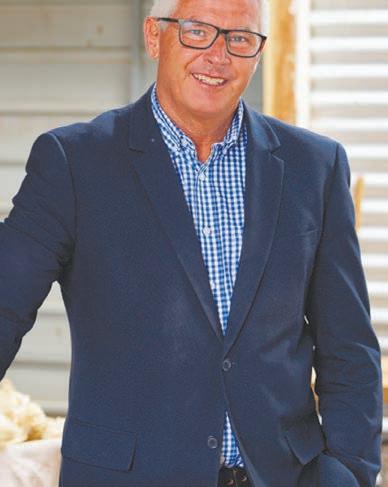
Heading into this spring, we are consistently seeing multiple offers at market price on the great majority of rural properties we are putting up currently. Buyers, too, can operate on what the property can actually produce, rather than competing head-on with alternative land uses or yet another national policy statement limiting land use options.
Our best advice is to get advice, whether buying or selling, this is not the year to step back There are real options on both sides of the table.
Talk to our team and they can walk you through our excellent listings within this magazine and/ or potential options available for the new season However, my advice is that the early bird gets the worm
Whether you’re looking to buy or sell your farm or lifestyle property, our True Team is here to exceed your expectations. With a perfect blend of energy and experience on your side, you can’t go wrong with Property Brokers.
Call 0800 367 5263 or visit pb.co.nz.
Conrad Wilkshire, GM Rural for Property Brokers Ltd
New Zealand Farm Sales by Month & 10 Year Median 2024/2025 Season + Year Prior (20ha+)


Wanaka 150 Fowler Lane




1.1853 hectare | For Sale $1,950,000
Priced at $1 95M with a rateable value of $2.25M, this is your chance to secure premium land at exceptional value
Tucked beside the Hawea River with views to Treble Cone, this rare offering delivers something truly special – a 1 1853ha sun-drenched titled site, ready for your dream home or holiday retreat. Part of an exclusive boutique development designed for lifestyle and legacy, with shared access to 19ha of community land Enjoy a dip in the private lake, host friends at the lakefront pavilion with BBQ and gym, or unwind as the river flows below Equestrian facilities, a solar farm, and plans for a tennis court and golf green complete the vision Just a short drive to the vibrant energy of Wanaka's town centre and surrounded by lakes, rivers, and mountains - this is where your next chapter begins.




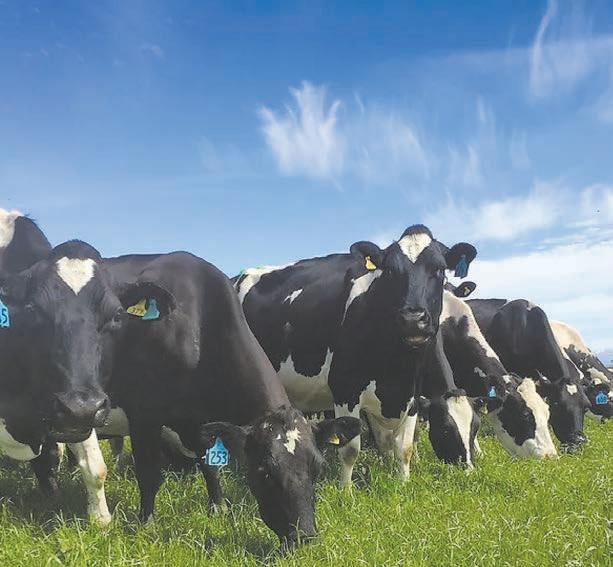

Wanaka

BAINHAM, NELSON 1629 Collingwood-Bainham Main Road
'Bonnyfield' Farm - Dairy Opportunity
'Bonnyfield' is a substantial 439ha farm, spread across six titles, located in one of Golden Bay’s most favoured and reliable dairy production regions. With consistent year-round rainfall, highly productive soils, and a strong history of performance, this property offers scale, flexibility, and genuine potential.
With current strong returns in the dairy sector, the property is wellpositioned for recommissioning as a full dairy unit. A mid-season takeover is possible as the vendor may consider selling a portion of their herd to support a smooth transition. The recommissioning of the dairy operation has been confirmed, and new owners have the opportunity to customise the infrastructure to suit their needs.

The effective area of approximately 330ha includes a 236ha milking platform and 92ha of runoff grazing, with the balance comprising mature native bush and some non-productive land.
Since 2016, 'Bonnyfield' has operated as part of a larger family farming enterprise, serving as a dairy support and grazing block, with portions incorporated into the home farm’s milking platform. The vendors have now made the decision to bring 'Bonnyfield' to market, presenting a rare opportunity to secure a significant landholding in a high-performing region.

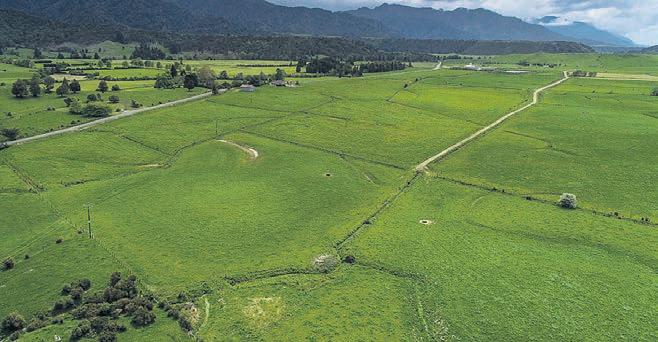

TENDER Plus GST (if any) (Unless Sold Prior)
Closes 1.00pm, Wednesday 24 September VIEW By Appointment Only
Joe Blakiston
M 027 434 4069
E jblakiston@pggwrightson.co.nz
Doug Smith
M 027 543 2280
E douglasjcsmith@pggwrightson.co.nz




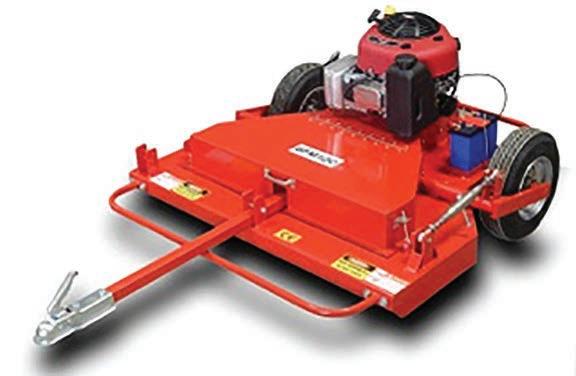











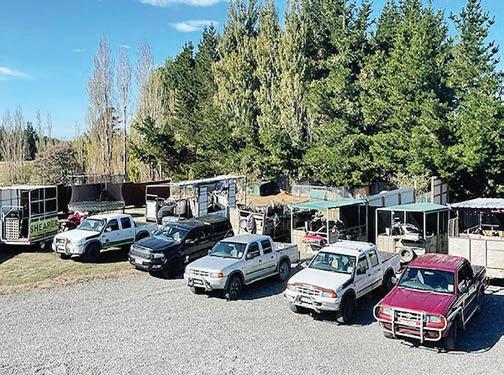

















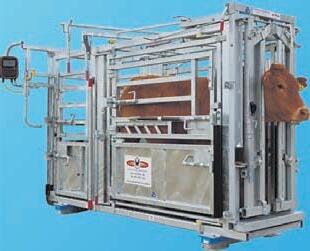

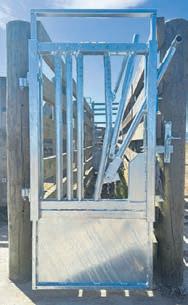








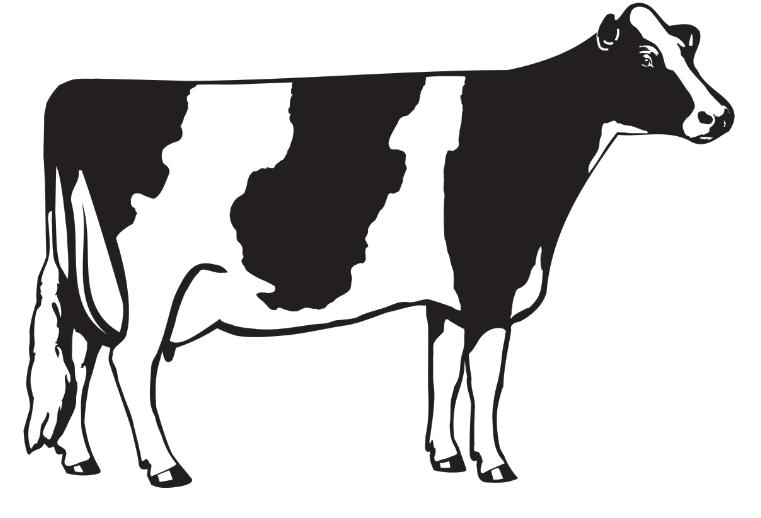
• Fast, easy and reliable
• Makes herd testing a breeze
• You will wish you did it years ago
Contact: Grant Jenkins | Mob: 027 896 6774 Email: grantjenkins32@hotmail.com
TRAVEL
INDIA & SRI-LANKA package tours. Visit www. maharajahtours.co.nz or email india@xtra.co.nz or call Craig on 021 193 0091 for details.
TREES FOR FARMS
ADDITIONAL INCOME. Stock shelter, erosion control, Truffle income, animal fodder, fireproof cork and Natives. 021garden.co.nz Litherland Truffles 021 327 637.
TREES FOR SALE
TOTARA’S FOR SALE. 80cm plus. $8+gst. Pick up Wairoa. Phone Jan 027 278 7033 or email j.doran@xtra. co.nz
WANTED TO BUY
WHAT’S SITTING IN your barn? Ford, Ferguson, Hitachi, Komatsu, JD. Be it an excavator, loader or tractor, wherever it is in NZ. Don’t let it rust. We may trade in and return you a brand new bucket for your digger or cash for your pocket. Email admin@ loaderparts.co.nz or phone Colin 0274 426 936.
FOR ONLY $3.30 + gst per word you can book a word only ad in Farmers Weekly Classifieds. Phone 0800 85 25 80.
MACROCARPA AND PINE TREES. Plantations, Shelterbelts, Farm lots. Big or small, Lower North Island, No obligation free quote. Call Grant 021 246 4329 HSF Ltd.



LEASE LAND
FARM FOR LEASE. Waiuku. 4brm house optional. 200 acres. Good water, electrics and yards. Lease negotiable. Phone 021 293 6361.
FOR ONLY $3.30 + gst
LEASE LAND WANTED
100+ HECTARE drystock block/s sought across the North Island. Experienced operator with proven record. Confidential enquiries welcome. Contact 021 453 410.
SALE TALK
A guy walks into a bar and tells the bartender, “If I show you a wild trick, will you give me a free drink?”
The bartender shrugs, “Sure, why not?”
The guy reaches into his pocket and pulls out… a tiny rat.
Then out of the other pocket, he pulls a teeny-tiny piano.
The rat stretches, cracks his knuckles, and starts playing the blues like a rodent Ray Charles.
Stunned, the bartender pours him a free drink.
After finishing it, the guy says, “Now, if I show you an even better trick, do I drink free all night?”
“Buddy, if you can top that, you’re drinking on me till closing,” the bartender replies.
The man pulls the rat and piano out again, and this time reaches into his coat and pulls out… a small bullfrog



HIGH PRESSURE WATER
PUMPS, suitable on high headlifts. Low energy usage for single/3-phase motors, waterwheel and turbine drives. Low maintenance costs and easy to service. Enquiries phone 04 526 4415, email sales@hydra-cell.co.nz PUMPS
RAMS FOR SALE
WILTSHIRES-ARVIDSON. Self shearing sheep. No1 for Facial Eczema. David 027 2771 556.
The frog clears his throat and starts belting out soulful blues lyrics. The rat’s playing, the frog’s singing — the bar is dead silent in awe.
Suddenly, a man rushes up and says, “I’ll give you $10,000 for that frog!”
The guy says, “Nope, not for sale.”
“$25,000!”
“Nope.”
&
many years siring tens of thousands of daughters around NZ
Many of the bulls on offer are bred from or closely-related to these highly-regarded cow families who have supplied these AI sires
The bulls are well-grown owner-bred and reared so tick all the health security boxes These G3-profiled bulls are ideal for keeping replacement heifers from You can purchase with confidence from this outstanding offering TB C10, BVD tested and vaccinated Online bidding available via BIDR Catalogues available visit www.agonline.co.nz
Contact:
Kent Stove 027 224 0999





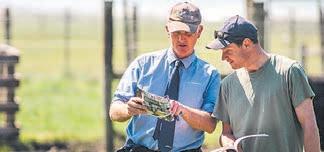

Key: Dair y Cattle Sheep O ther


Otengi Polled Herefords
M:021 526 009
E: philip@otengiherefords co nz
PAUL SHEPHERD
Waimaire Polled Herefords
P: 09 405 0294
M:021 893 644
E: paul@waimairehereford co nz

All bulls are:
We’ve done the work for you!
All bulls are:
We’ve done the work for you!
• Performance recorded for 55 years
• Performance recorded
• Craigmore has genomic tested >200 cattle per year since 2018
• Genomics tested to improve accuracy of EBVs
Polled gene tested
• Polled gene tested
• BVD tested
• BVD tested
YEARLING BULL SALE
YEARLING BULL SALE
On farm bull sale plus online sale at bidr Sign up at www.bidr.co.nz
On farm bull sale plus online sale at bidr Sign up at www.bidr.co.nz
Monday 8th September 2025, at 12.30pm Luncheon available On A/C D.B & S.E Henderson
Monday 11th September 2023, at 12.30pm Luncheon available
On A/C D.B & S.E Henderson
At the stud property: 429 Rukuhia Road, RD 2, Ohaupo
SPECIAL OFFER
For every bull purchased the buyer will receive a bonus package of 15 semen straws of Craigmore 23251 for use in commerial and dairy herds
At the stud property: 429 Rukuhia Road, RD 2, Ohaupo 100+ registered well grown bulls
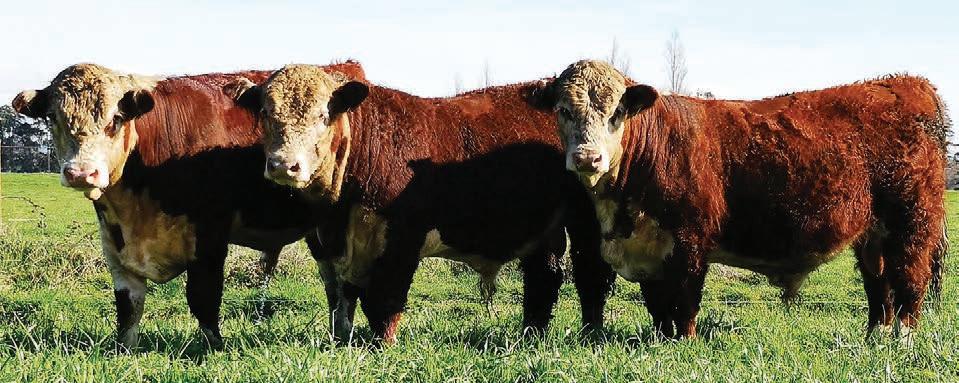
Craigmore has been breeding Hereford cattle for over 50 years! We have bulls that will suit beef and dairy farmers www.craigmoreherefords.co.nz

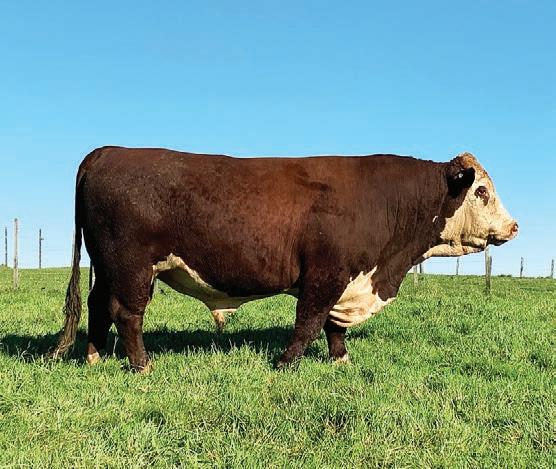

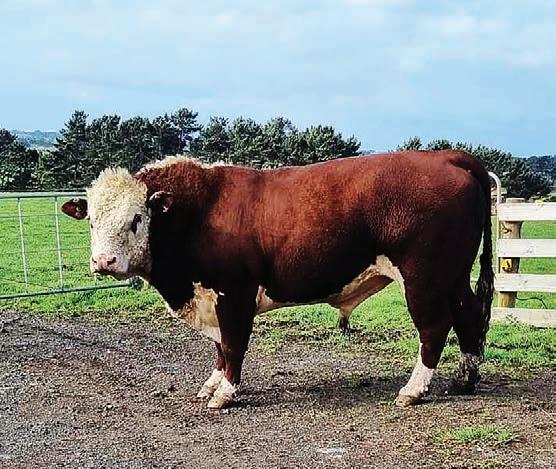
TARANAKI CATTLE FAIR















• 12 registered pure bred Speckle Park yearling heifers
• 13 Registered pure bred Speckle Park yearling bulls
• 7 F2 and F3 Speckle Park X Angus bulls
BVD vaccinated and tested free.
Soldiers Road, Tauranga and Live-streamed on
available at a later date www.korakospecklepark.co.nz
GRAEME & RACHEL BROWN P: 021 037 2350 • E: maranui.stud@xtra.co.nz

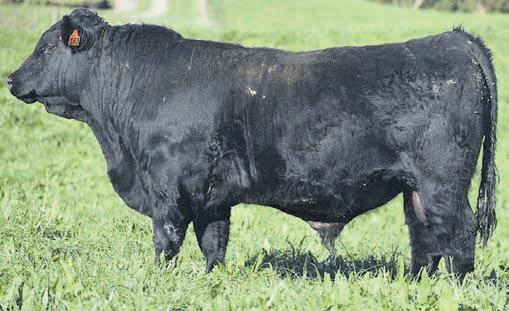
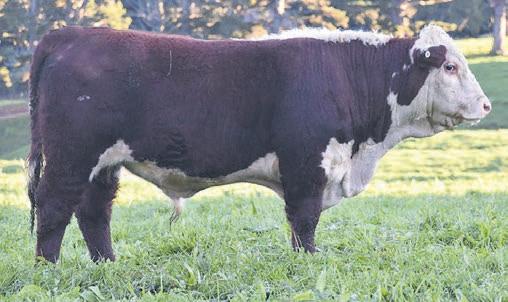


25 Hereford and 12 Angus Performance Recorded & Carcase Scanned Yearling Bulls
year’s offering includes:
• Lots 1–14: R2 Jersey bulls (ave BW 290 up to BW 357)
• Lots 15–74: Elite R1 Jersey bulls, sold by Link Livestock (ave BW 254 up to BW 337)
• A further 142 R1 Jersey bulls, sold by New Zealand Farmers Livestock (ave BW 227 up to BW 299)
• All bulls have been double vaccinated for Lepto and BVD, and TB tested They come from a closed herd, so you can buy with confidence.


and http://www.linklivestock.co.nz/upcoming-sales/





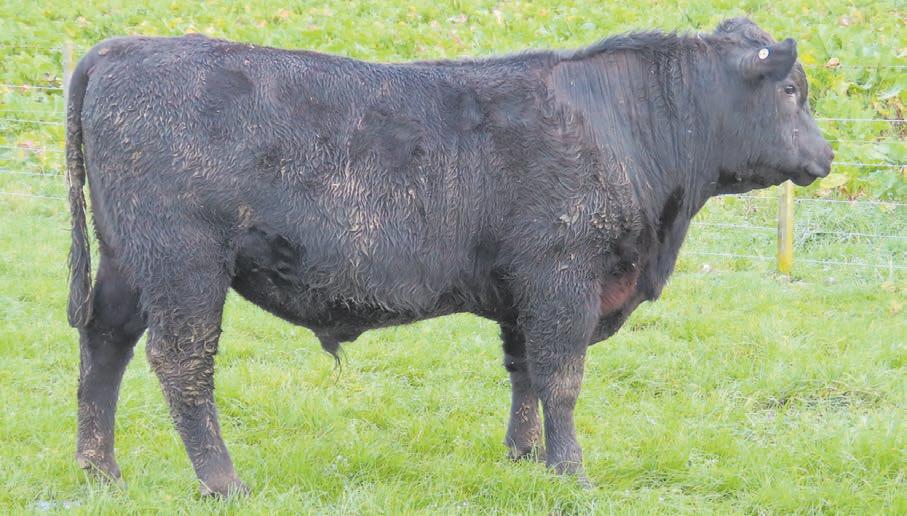



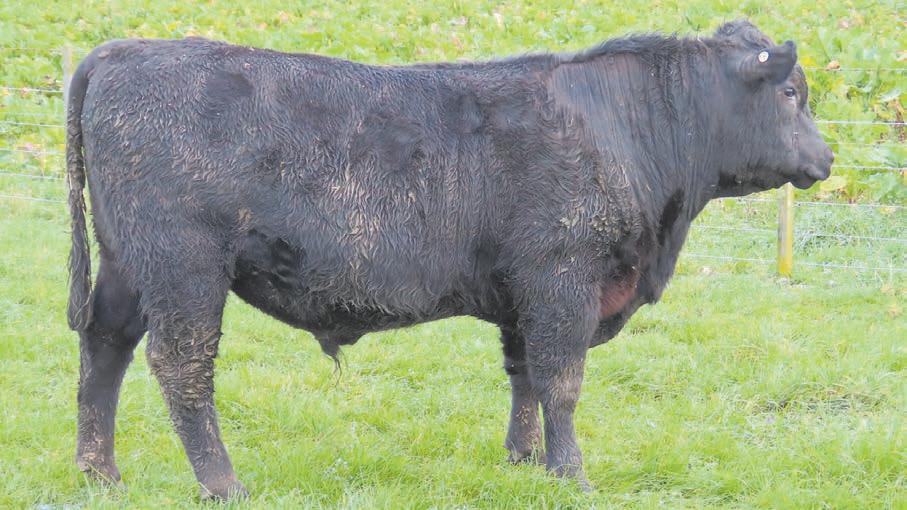

Sector’s apex hogget fair reaches new heights
The Feilding Marton Hogget Fair is the pinnacle of lamb trading at this time of year and the 2025 fair did not disappoint.
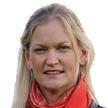
Suz Bremner MARKETS
Livestock
THE pinnacle of lamb trading at Feilding at this time of year is the Feilding Marton Hogget Fair, which was held on Wednesday, August 13. This annual fair is steeped in history, dating back to its roots at the Marton saleyards with the first official recording of the fair in 1920, when 8000 hoggets were offered.
At its peak, it was a two-day event with more than 20,000 mainly ewe hoggets sold each day. Roll on 105 years and this fair is still supported by some of the original families through the generations, and is a day that farmers will still farm their hoggets to.
Feilding is known for putting up high tallies of store hoggets at the regular Friday sales, but there is just something special about selling at the Feilding Marton Hogget Fair, and buyers also tend to be a bit more competitive to secure the larger lines of mainly short-term hoggets, as well as supporting a great cause in the Cancer Society.
A very favourable season for lamb prices, both at the processors and in the paddock and saleyards, has meant that farmers have carried hoggets to heavier weights to gain optimum value, even to
the point that the recent Beef + Lamb NZ survey said more trade lambs were on farm at the end of the financial year on the east coast and in Taranaki-Manawatū, as well as all areas of the South Island.
This was evident at the hogget fair as tallies lifted 3000-head on the first hogget fair last year. This comes as the fair crawls its way back from a very quiet year in 2022, when a wet and cold winter meant slow growth rates for hoggets, and buyers were not prepared to sell into the deflated market.
That certainly wasn’t an issue this year, on both fronts – the hoggets put forward have enjoyed a favourable winter and farmers have enjoyed very favourable prices.
Processor buyers were very active on the short-term lines, exemplifying the shift of this fair traditionally supplying breeding ewe hoggets to now focusing on trade and finished hoggets.
There was plenty of interest in the longer-term types as well, though these were few and far between with only a handful of hoggets weighing sub-35kg. Most of the male hoggets offered pushed over 40kg and ewe hoggets 38kg and better.
Buyers were hard pressed to spend less than $180 per head at this fair, whereas the average price for 2024 was lower than that at

It is early days, but the ewes with lambs-at-foot market is already proving to be very lucrative.
$173 per head. This year’s average per head price was $240, bettering the closest year of 2021 by $48 per head, while the best of the best male hoggets reached $300-$311.
As focus starts to shift from the old season lambs to the new, a great way to get early lambs on farm without lambing down is through the ewes with lambs-atfoot market. It is early days, but this market is already proving to be very lucrative, especially since BLNZ figures show that the number of ewes mated this season is down 1.9% nationally (277,000 head).
While multiple lamb numbers are expected to be better, which will go some way to cushion the impact of the lower ewe numbers, the fact remains that there are expected to be around 120,000 fewer lambs on the ground this coming season, continuing the current downward trend.
Therefore, the ewes with lambs-
at-foot market is a very attractive option, and small entries offered around the country have already proved that point.
The ball seems to have fallen around the $125-$130 allcounted mark at this early stage, dependent on the age of the lamb and ewe condition, though up to $139-$146 all counted has been paid for lines with older lambs.
BEST OF THE BEST: The crowd gathered in the sunshine and hoggets continued to sell at the record levels seen this season. This line of male hoggets were the best of the best and sold for $311 per head.
Cattle Sheep Deer

Weekly saleyard results
These weekly saleyard results are collated by the AgriHQ LivestockEye team. Cattle weights and prices are averages and sheep prices are ranges. For more detailed results and analysis subscribe to your selection of LivestockEye reports. Scan the QR code or visit www.agrihq.co.nz/livestock-reports
| August
Frankton | August 19 | 576 cattle
Frankton | August 20 | 399 cattle
|
Friesian cows, 470kg
Prime lambs, all
Taupo | August 18 | 368 cattle
Aut-born weaner Charolais-dairy steers, 140kg
Aut-born weaner Charolais-dairy heifers, 135kg
Friesian cows, 535kg





Prime ewes, most
Prime mixed-sex lambs, most
Charlton | August 14 | 661 sheep
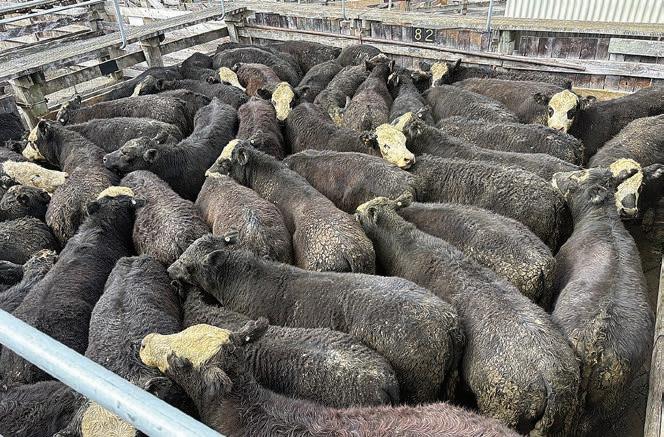
Lorneville | August 19
lambs, all
Prime ewes, all
Prime lambs, all
Feeder Calf Sales
Tuakau | August 18 | 405 cattle
Friesian bulls, all 20-105
Hereford-Friesian (black) bulls, all
Hereford-Friesian (red) bulls, all
Angus-dairy bulls, all
Charolais-dairy bulls, all
Hereford-Friesian (black) heifers, all 70-180
Hereford-Friesian (red) heifers, all
Frankton | August 19 | 1576 cattle
Hereford-Friesian bulls, all
Angus-dairy bulls, all
Charolais-dairy bulls, all
Hereford-Jersey bulls, all
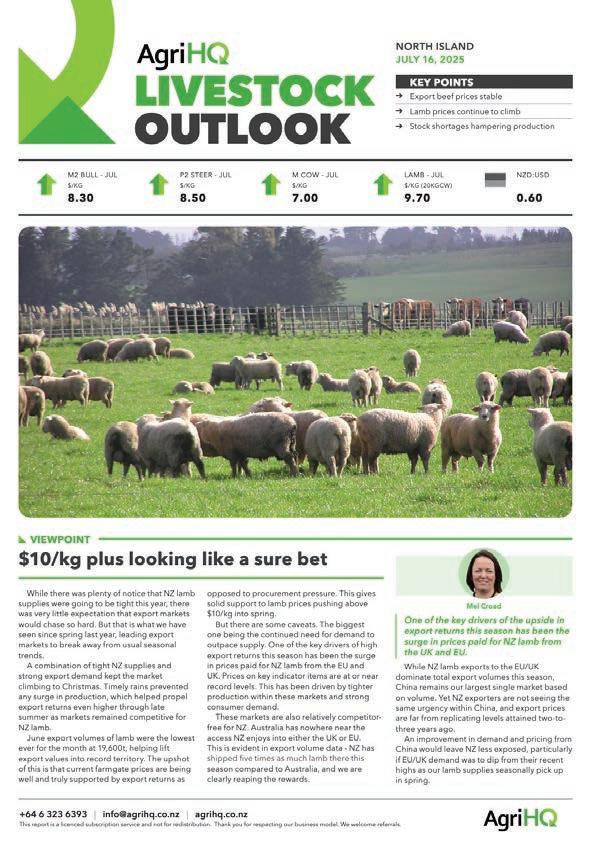

Philip Duncan NEWS Weather
ESPITE some heavy downpours here and there, more than 50% of the nation has had below normal rainfall so far in August, and some locations only getting 10 to 20% of normal rainfall (Farewell Spit area, coastal south Canterbury and Horowhenua).
The dry stretch has been thanks to some very powerful high pressure zones and has helped become winter’s balancing act following a very wet start to the season in a number of regions.
Now, as we head to September, we leave behind a month that was colder and drier in many places than previous months have been.
For some parts of Hawke’s Bay it hasn’t been a balancing act – some areas inland to the south have had very little rain this winter on top of an already drier than usual set up from autumn.
Not all places have had below normal rainfall. The Far North, northern parts of Northland, East Cape, northern Hawke’s Bay and a small part of western Southland have had a little
more than average (but not a huge amount more).
With so much high pressure, and a lot of southerly and southeasterly airflows, from a sunshine point of view it’s been cloudier than usual in the eastern North Island, plus also Northland and Wellington.
It’s been brighter than usual in Waikato, western Bay of Plenty, King County/Waitomo, Central Plateau and Whanganui.
As for the weather going into September – you may notice a windy westerly theme developing with a mix of cold fronts.
In the South Island it’s been sunnier along the top half of the West Coast, Mackenzie Country and central and south Canterbury, with only Stewart Island and the Catlins being a tiny bit cloudier.
August’s temperatures ... well, it will be of little surprise to most of you that August was colder than usual in a number of regions.
King Country/Waitomo, western Manawatū/ Horowhenua were below normal by the most, at around 1.2 to
2degC colder than usual in August so far.
But many other regions around New Zealand were either below normal, normal, or only 0.5degC above normal.
Nowhere in NZ stands out as being especially warmer than usual, but if we had to give an award to both islands it would go to parts of Northland and northern rural Auckand, along with Fiordland and Stewart Island in the South Island. These areas were only 0.5 to 1degC above normal and were fairly isolated.
The North Island has tilted colder than usual this month, while the South Island was below normal generally, but closest to normal.
That’s a sign of polar air that would normally remain over the South Island going much further north, something we’ve seen a lot lately.
So with September almost on our doorstep, what does the forecast look like ahead?
August’s final week may see some northern rain late week, then some West Coast rain this weekend.
As for the weather going into September – you may notice a windy westerly theme developing with a mix of cold fronts. Still wintry at times, but hints of spring weather look to finally be on the horizon now.

NORTHERN EXPOSURE: Polar air has spent a lot of time further north over NZ this month, normal for the South Island in winter, but making the North Island colder than usual due to it lingering so far north for so long.
